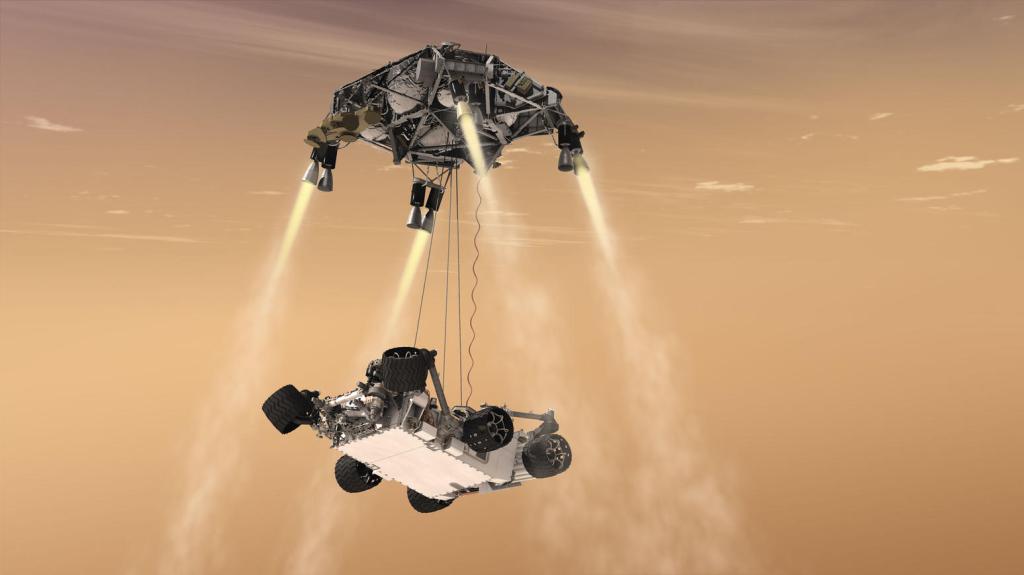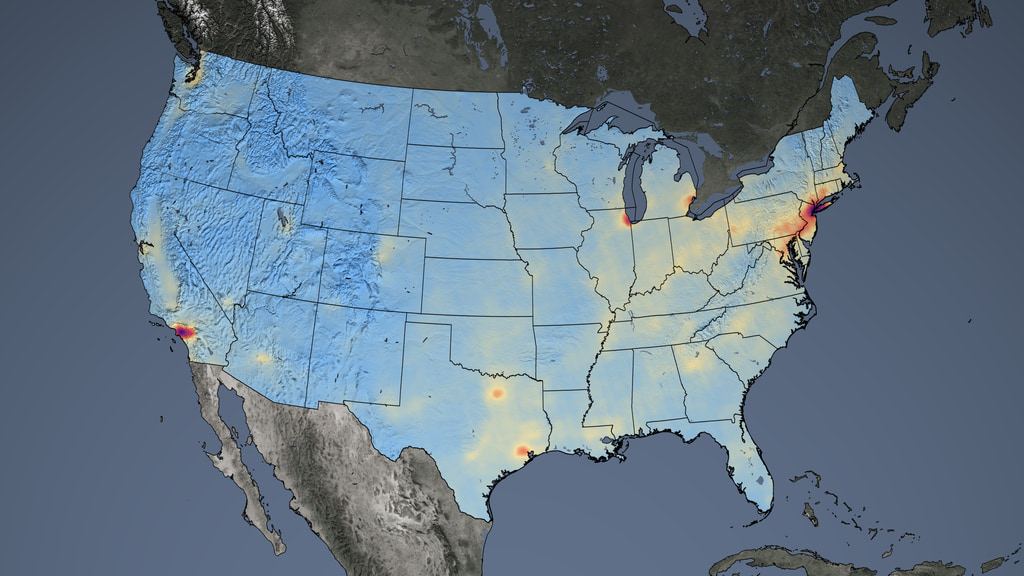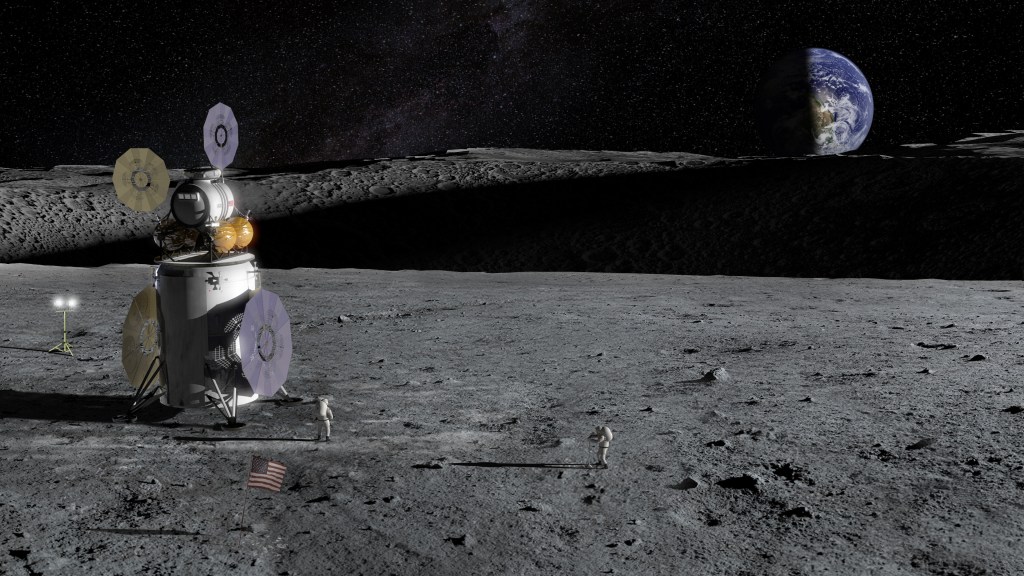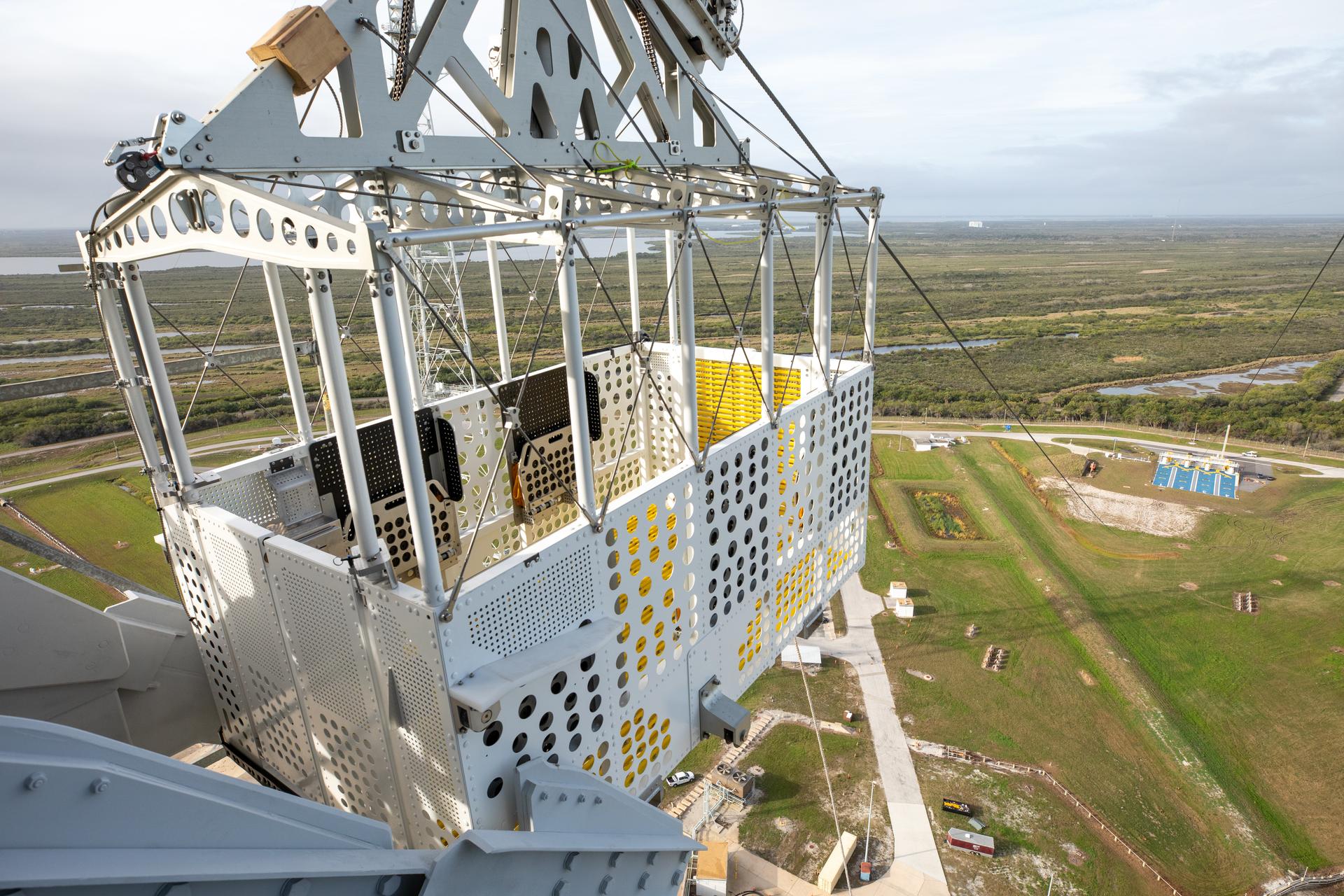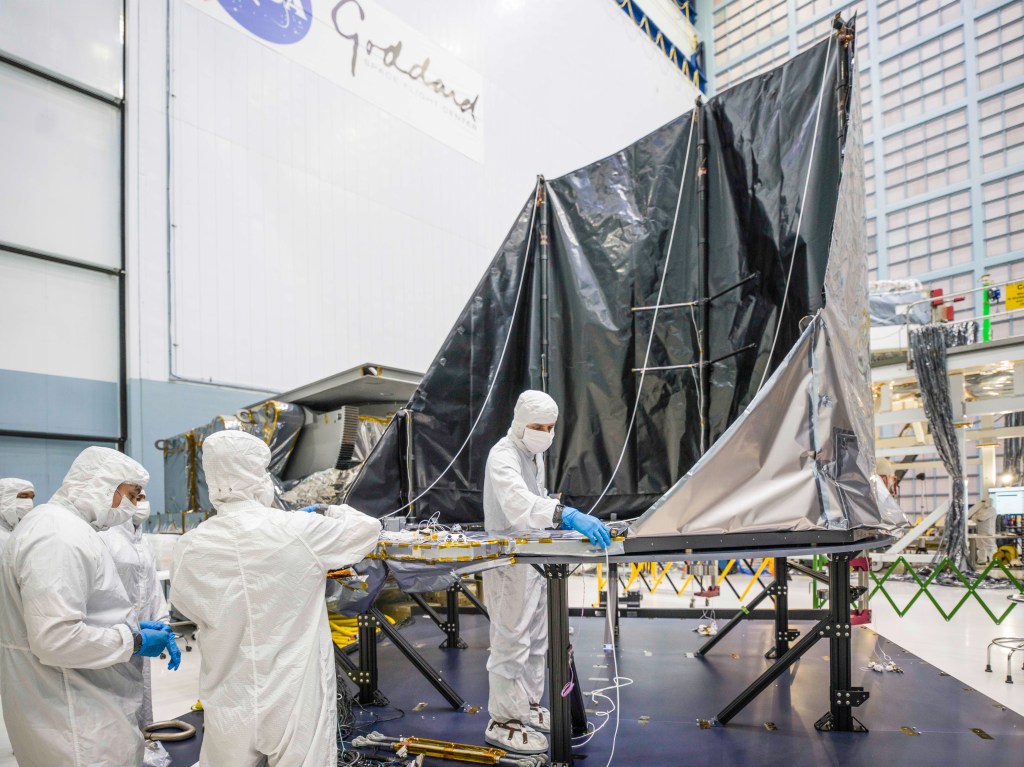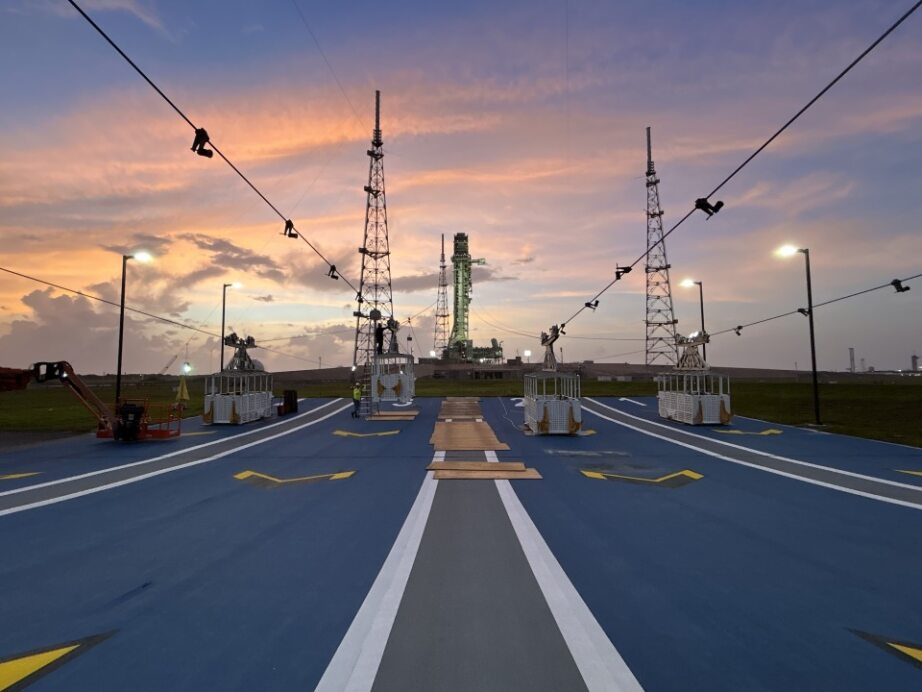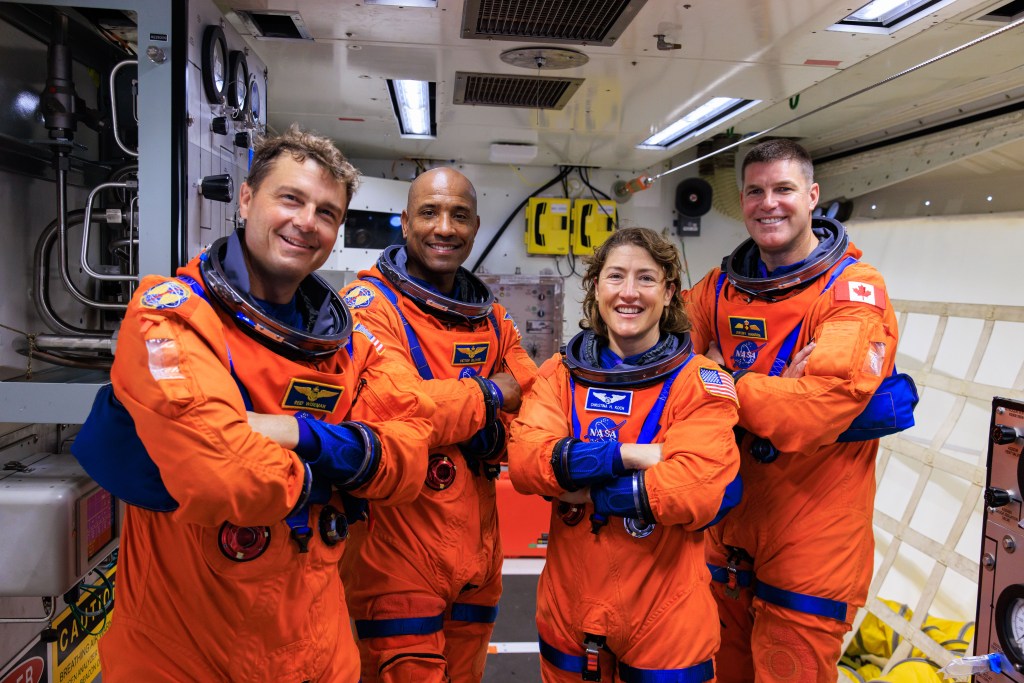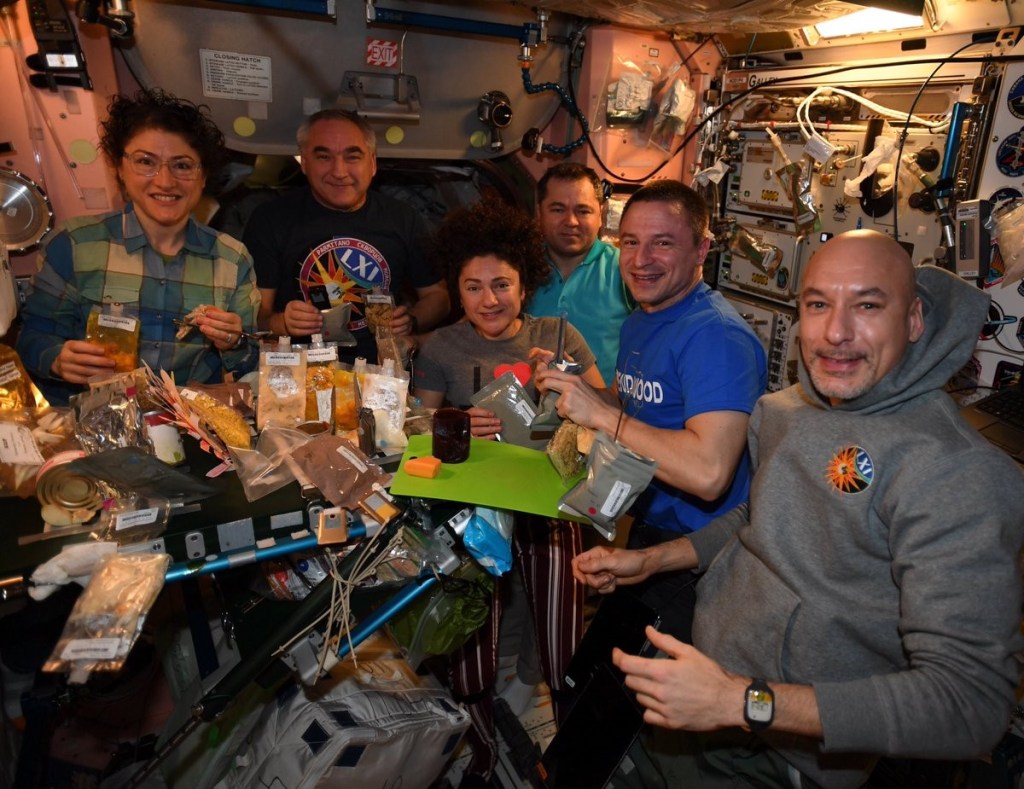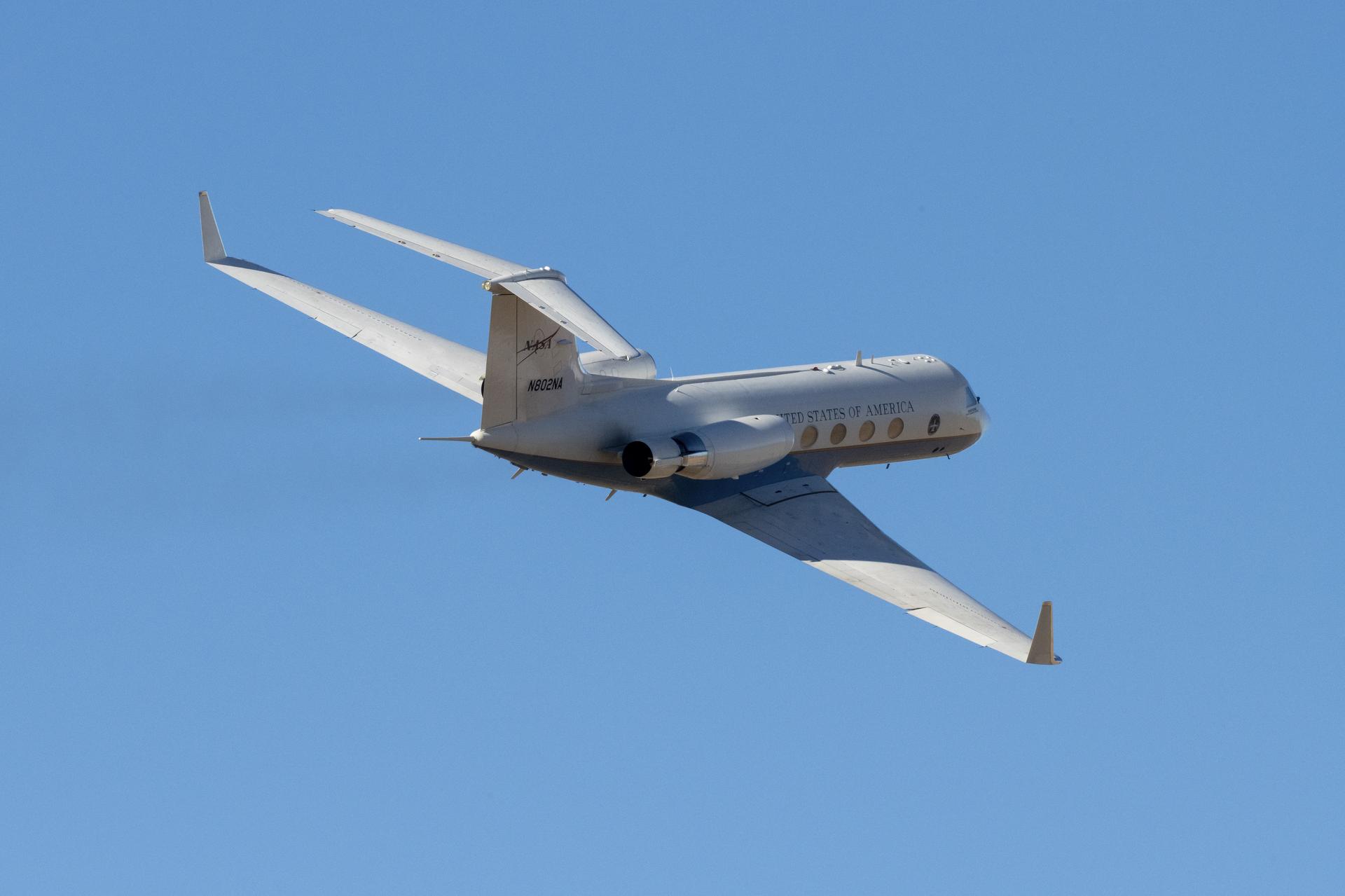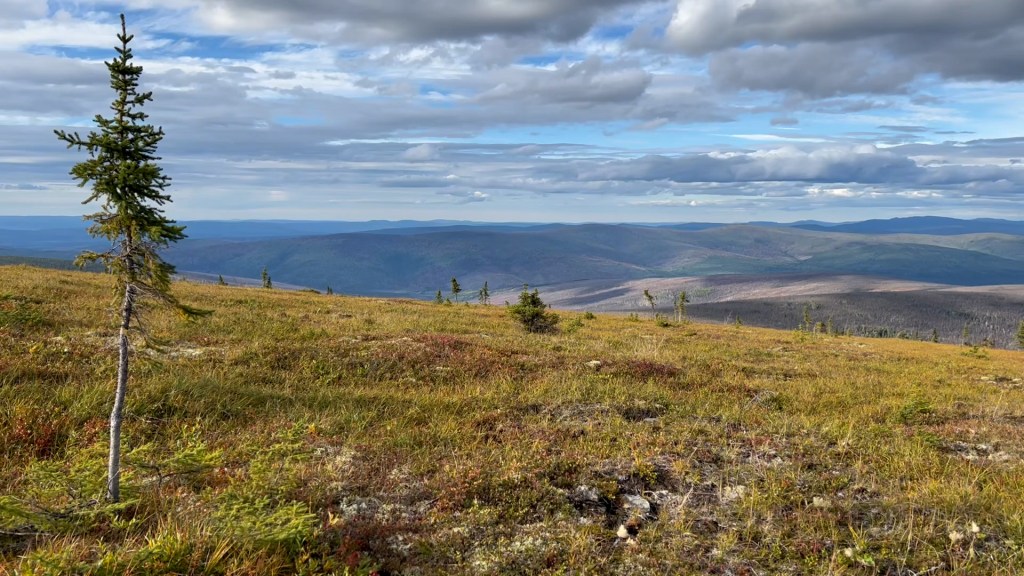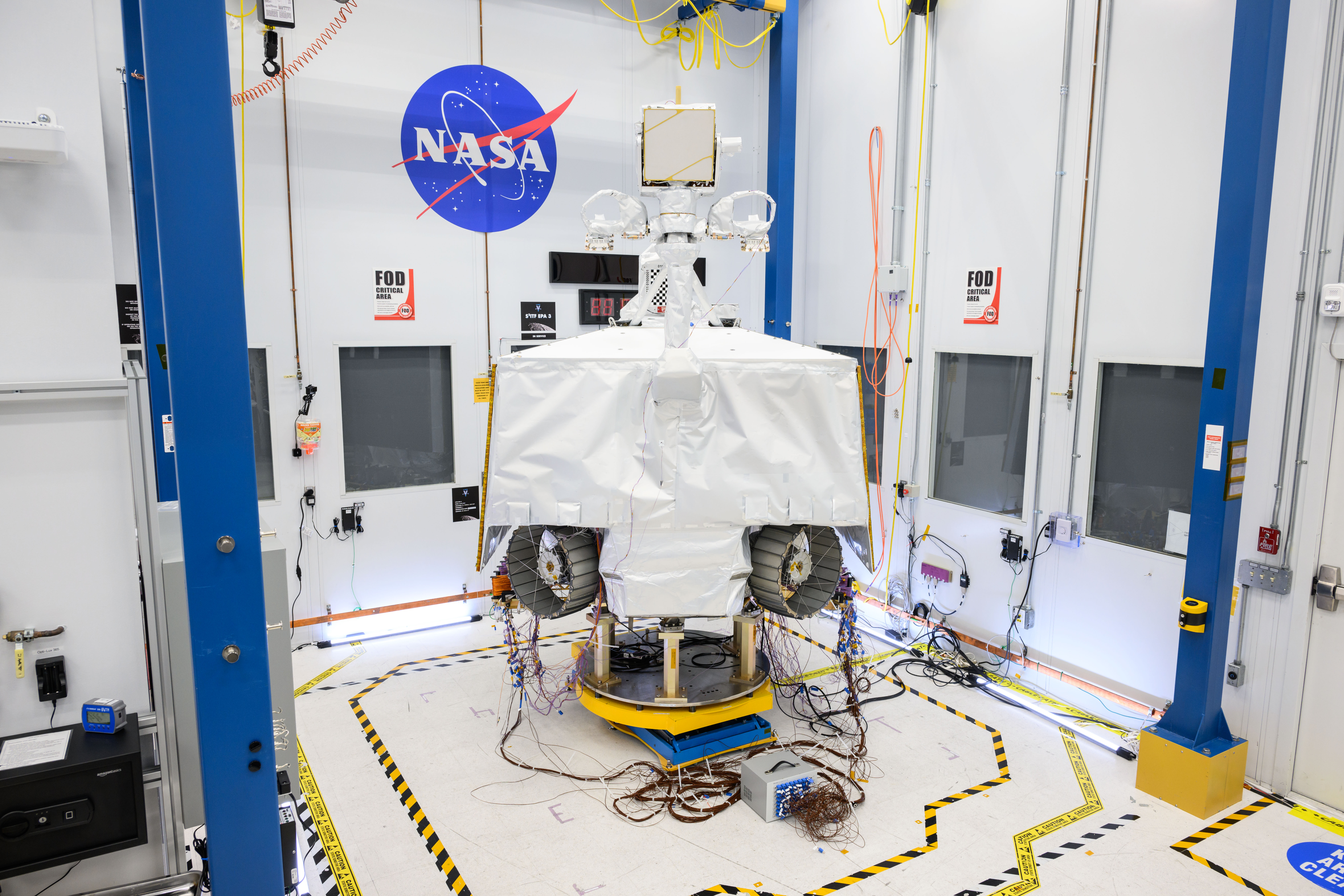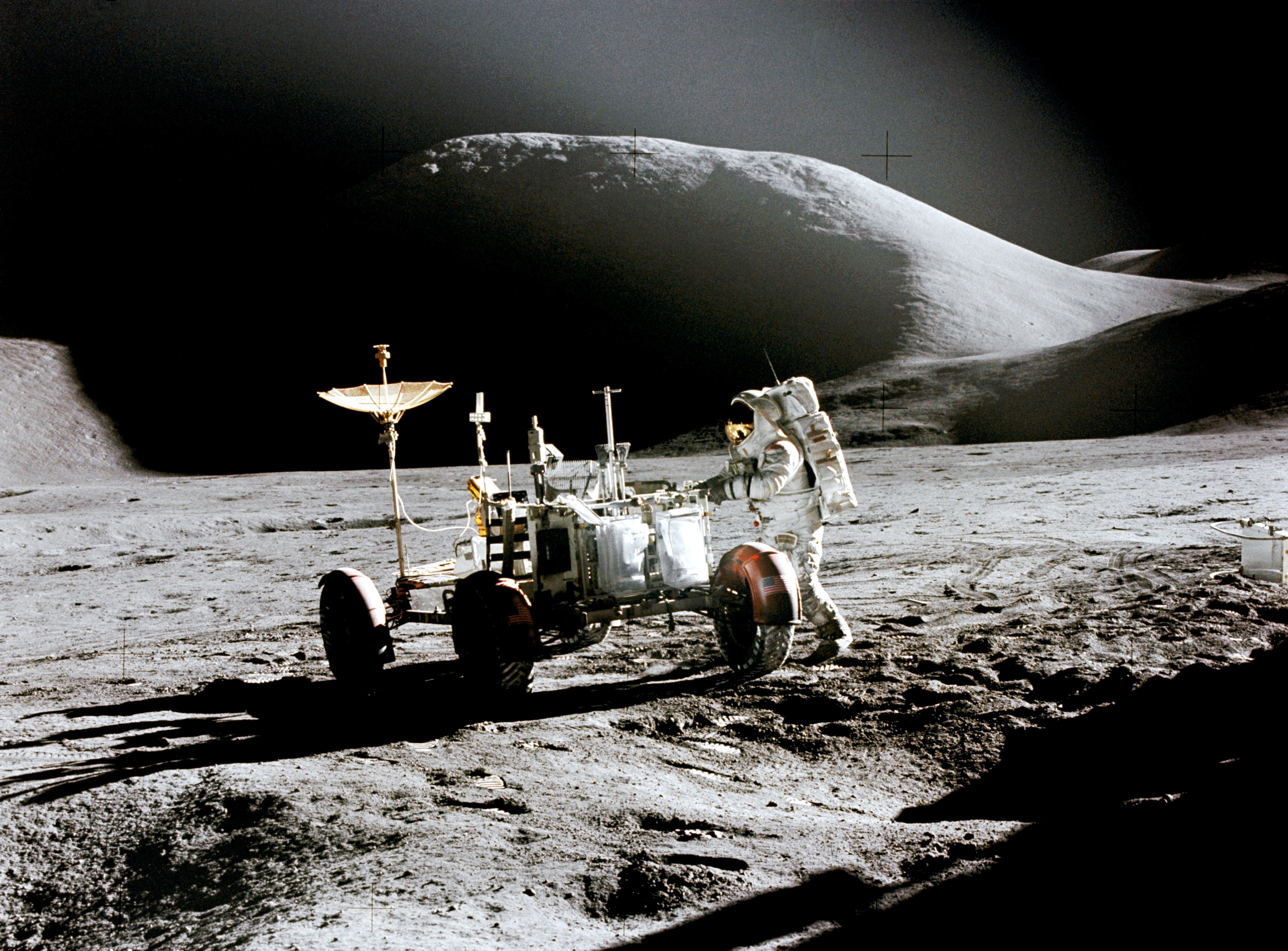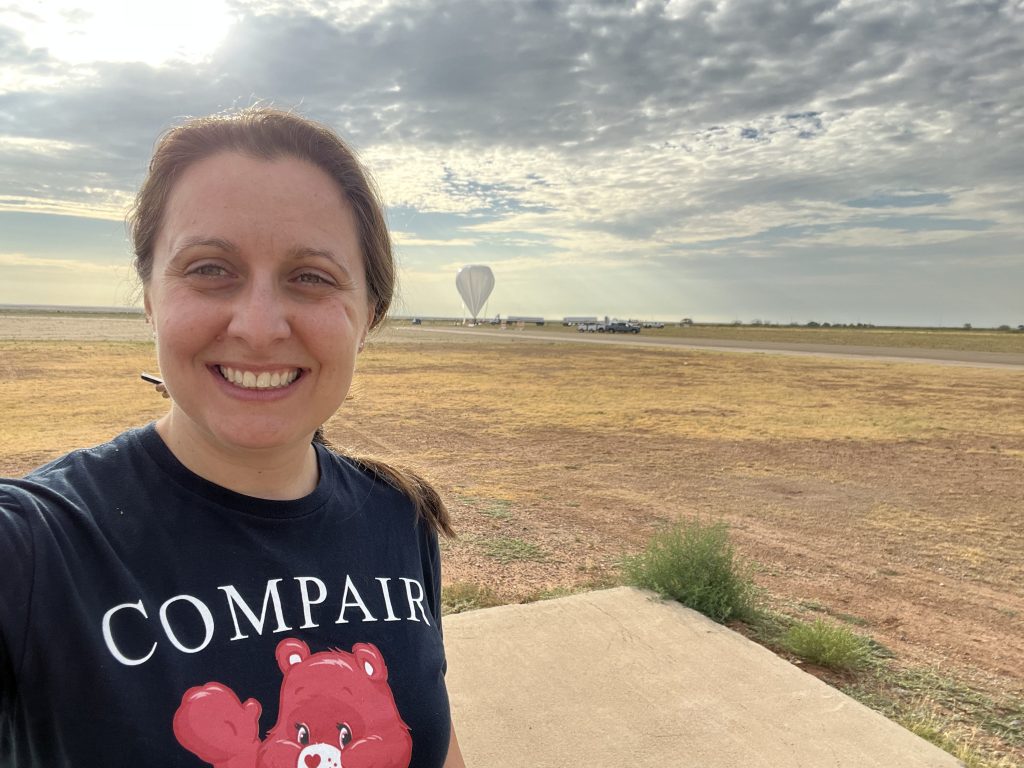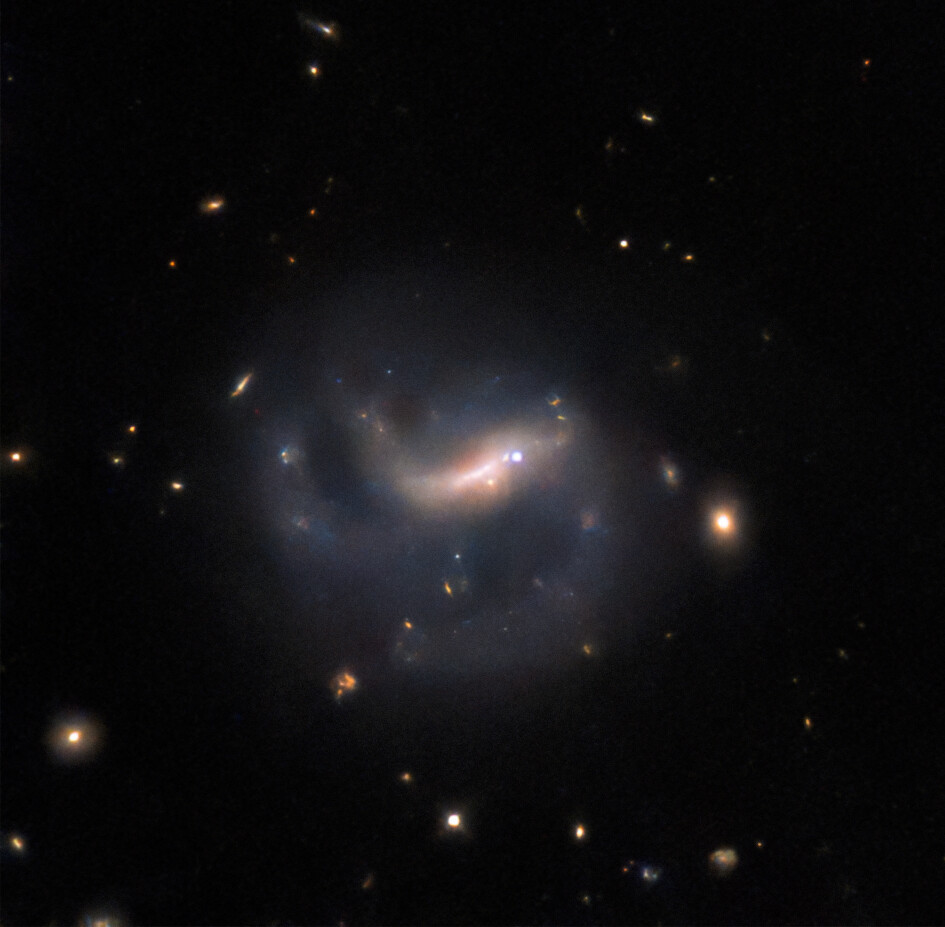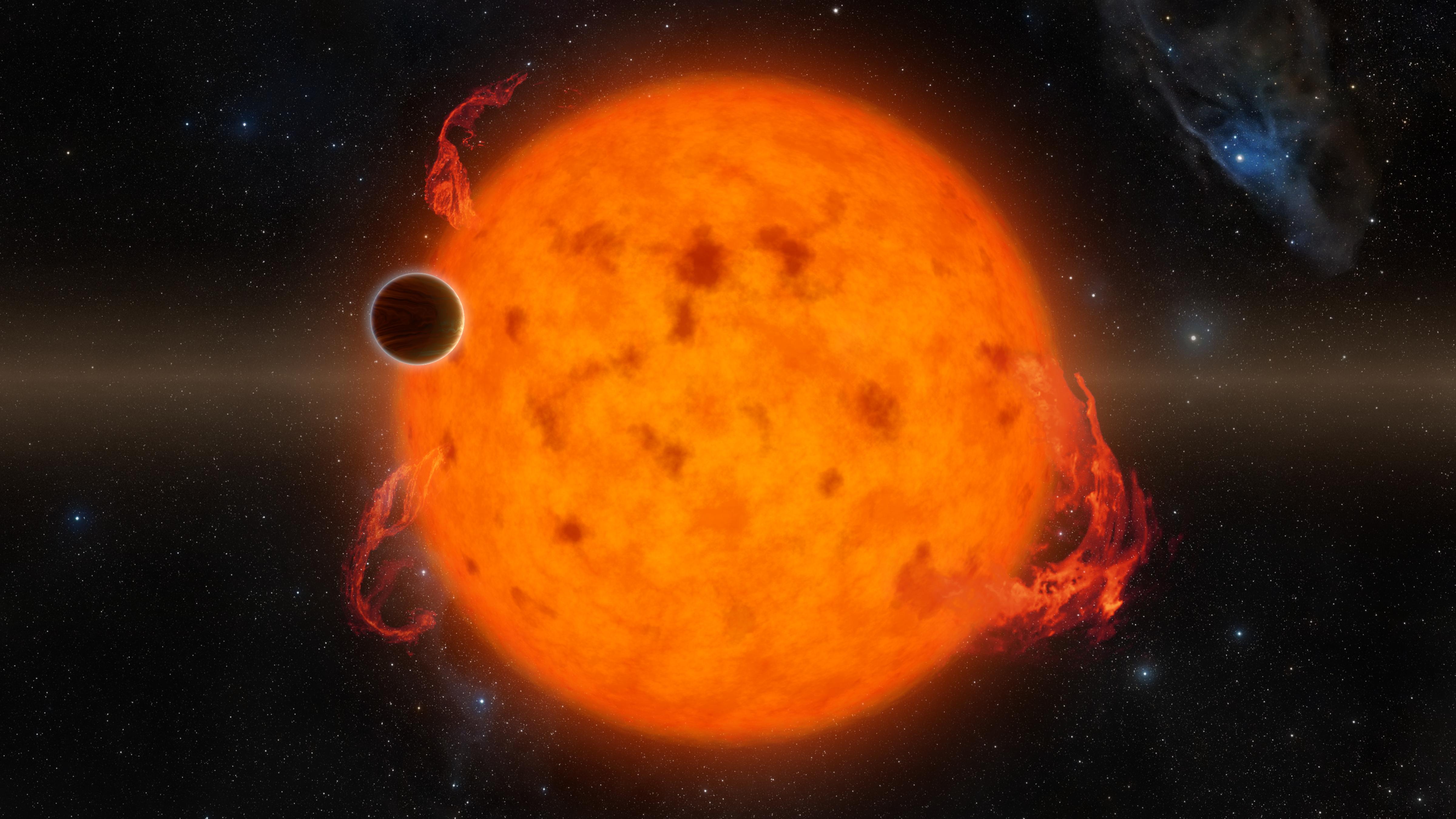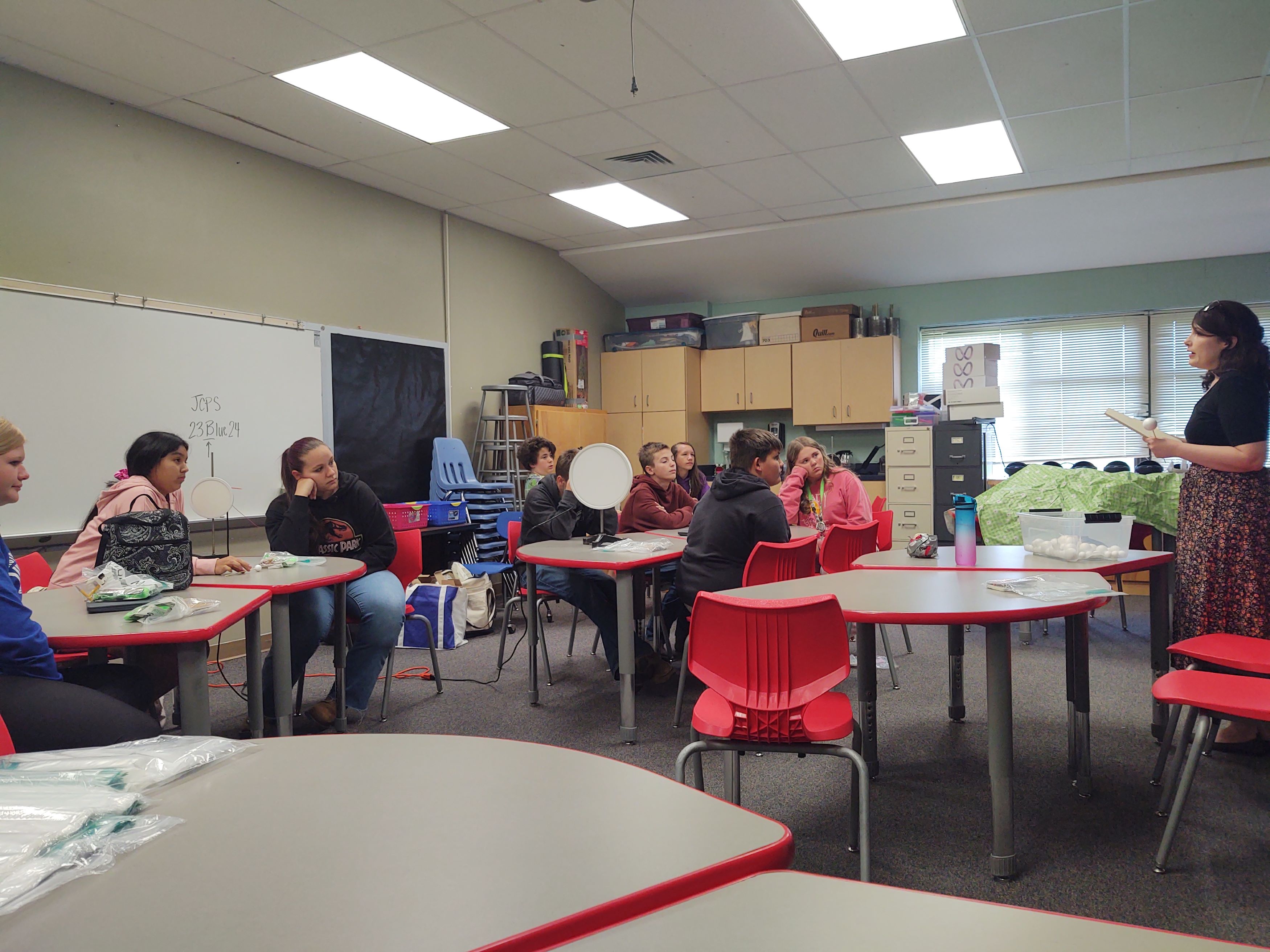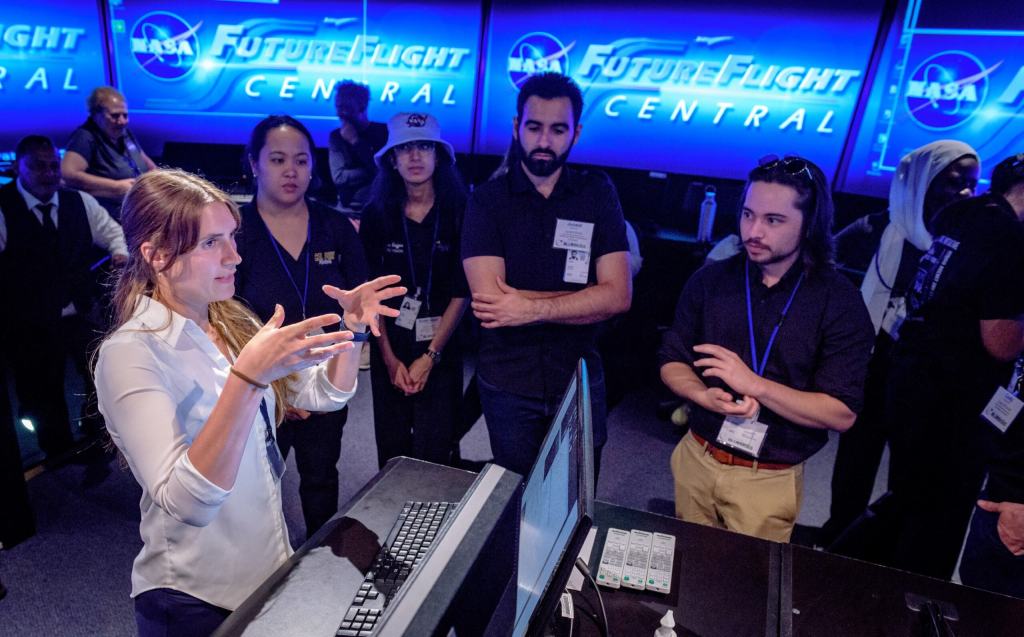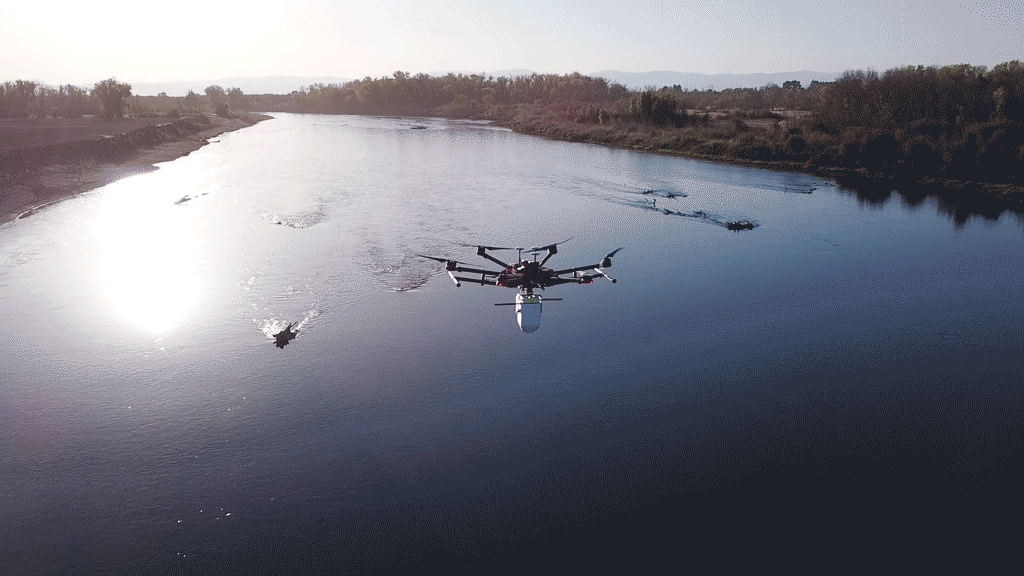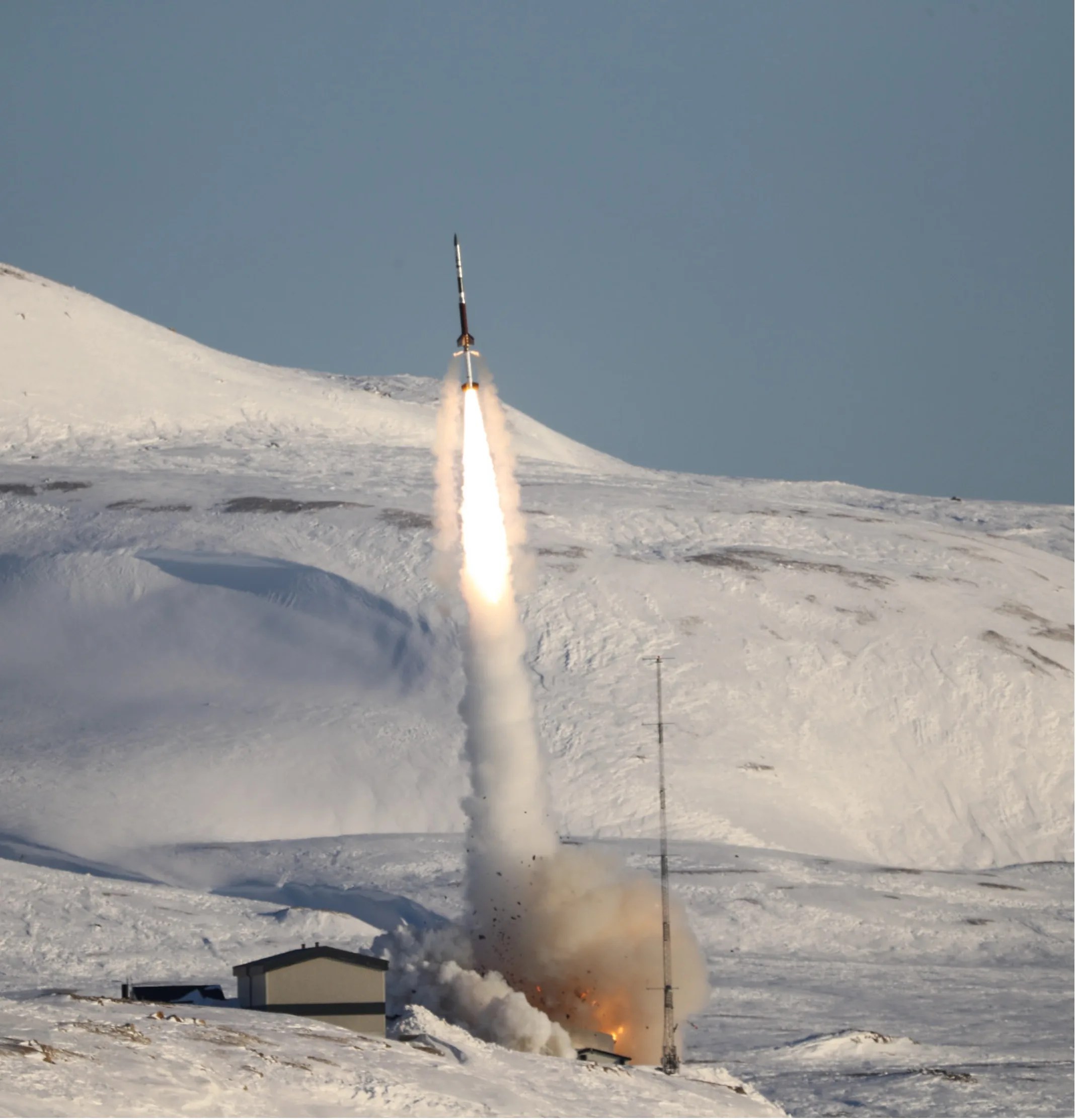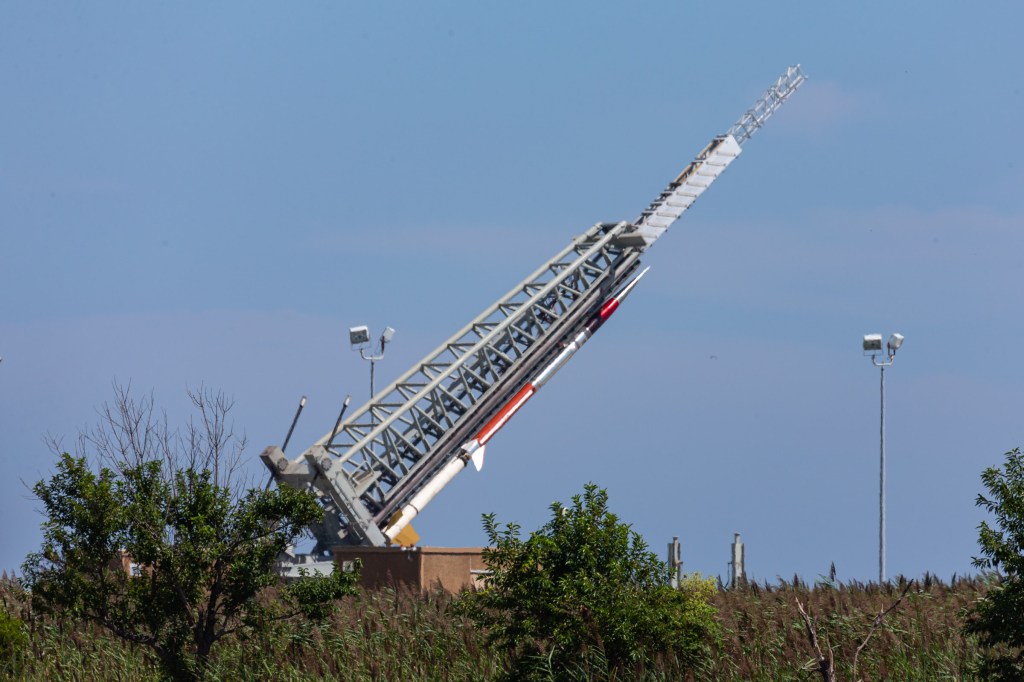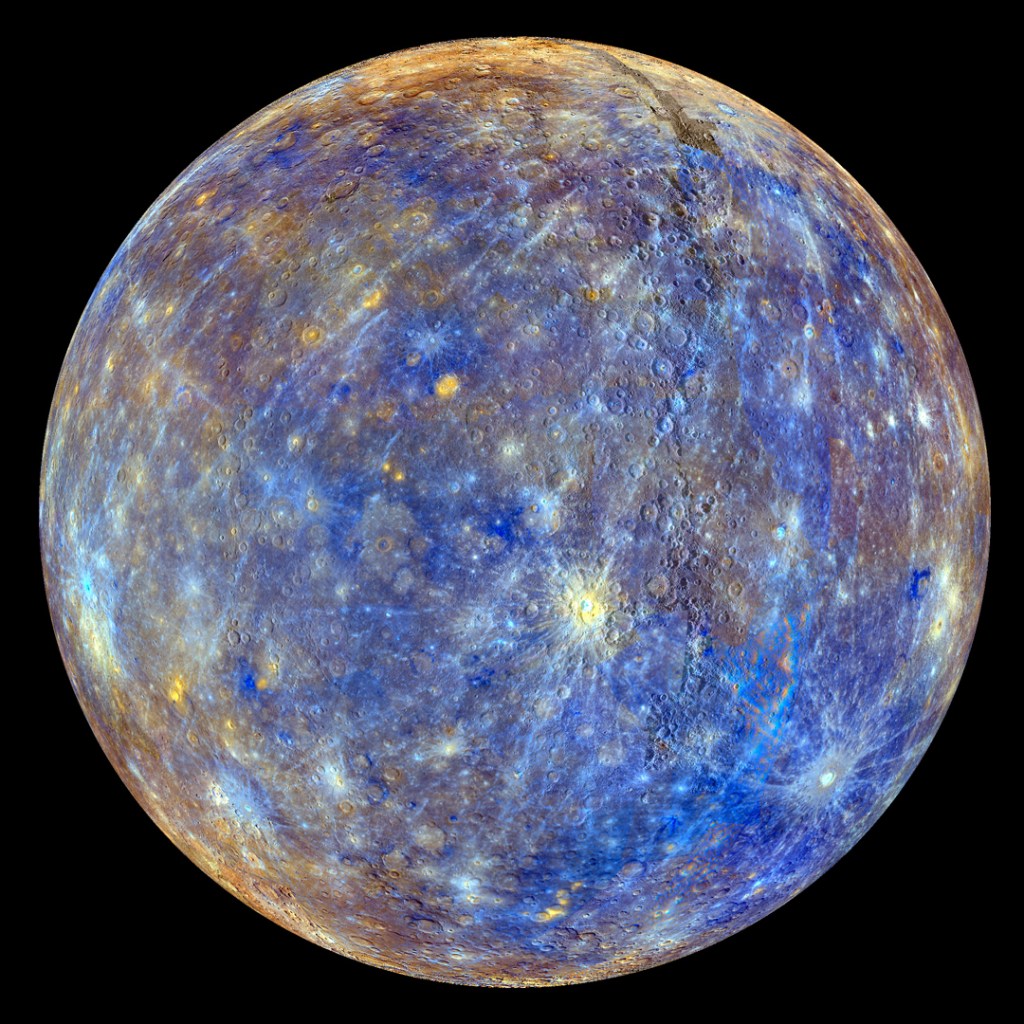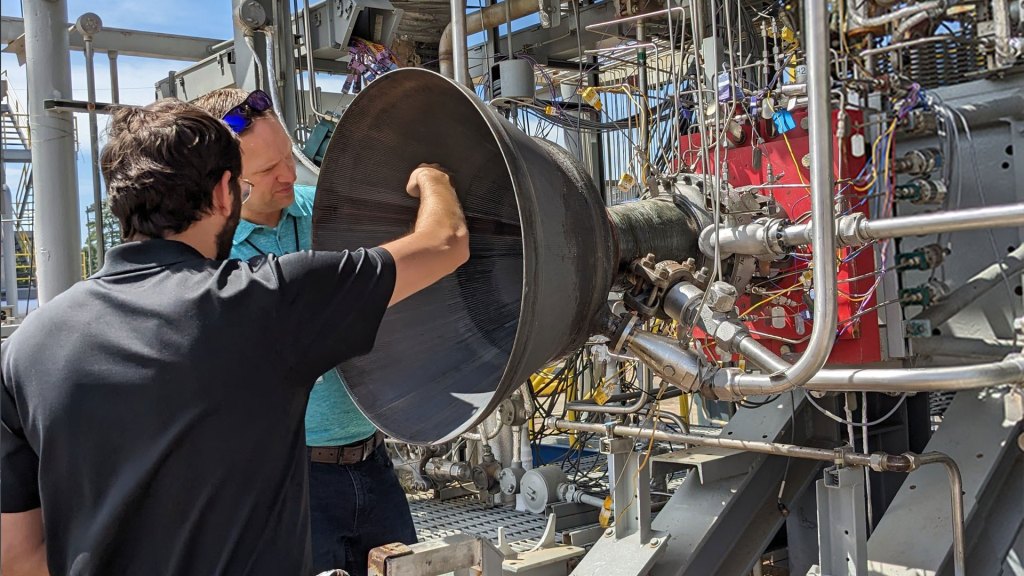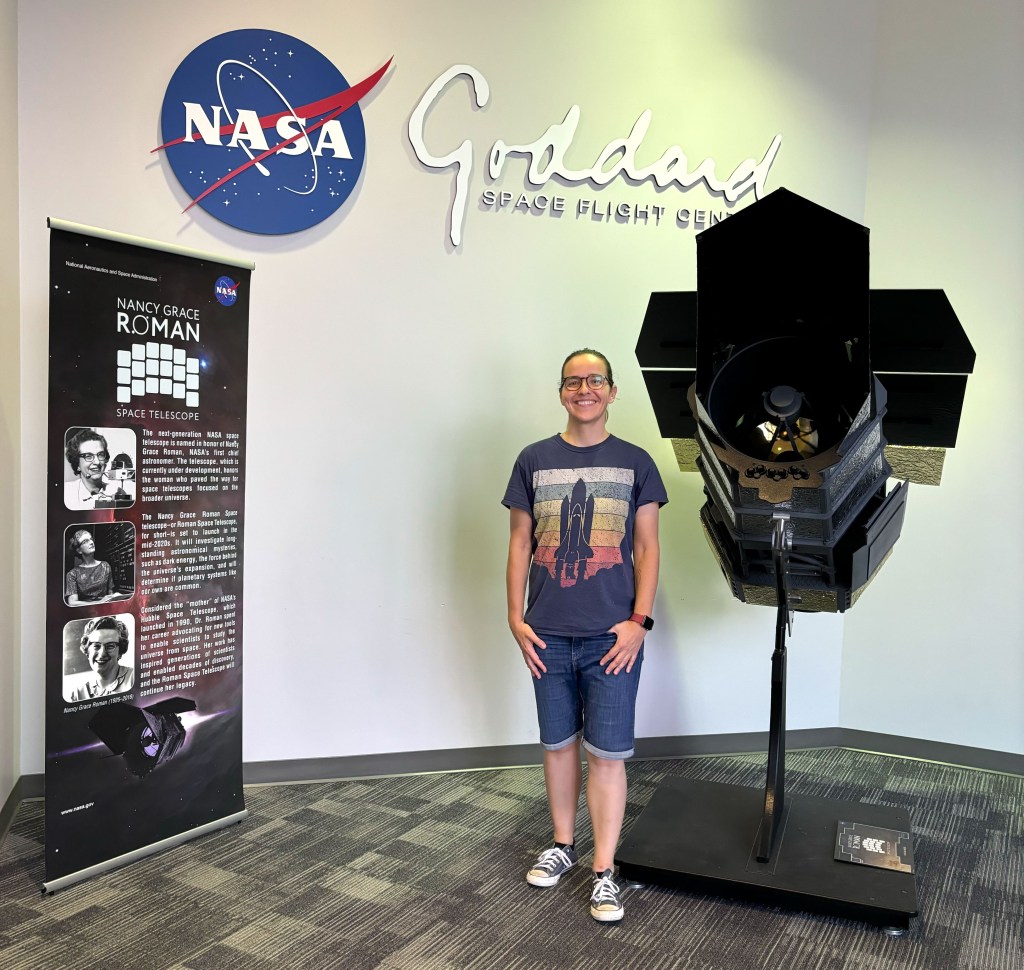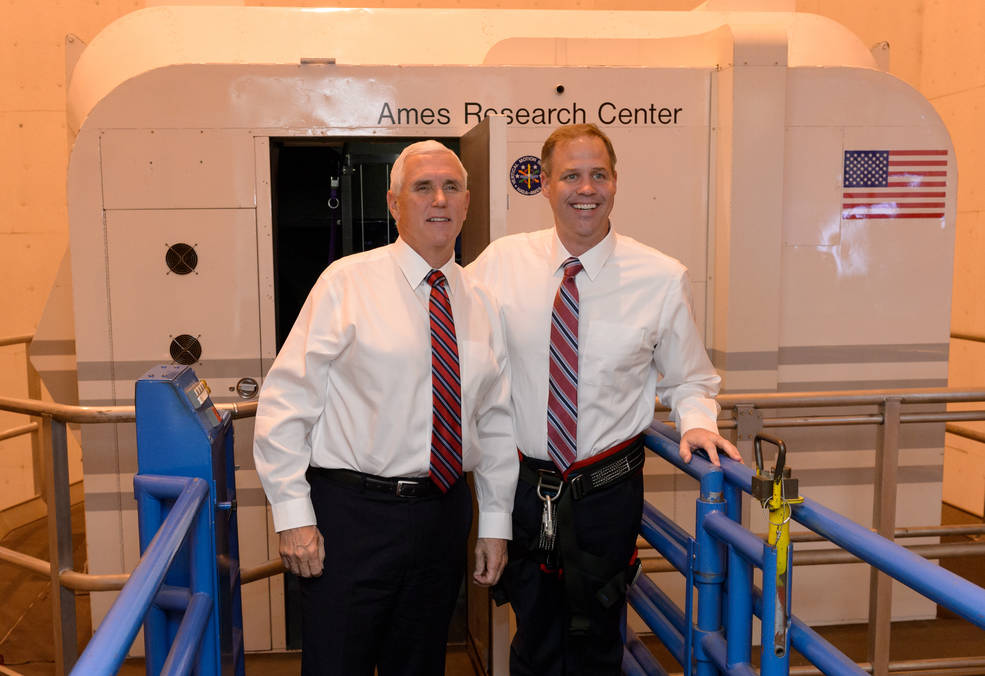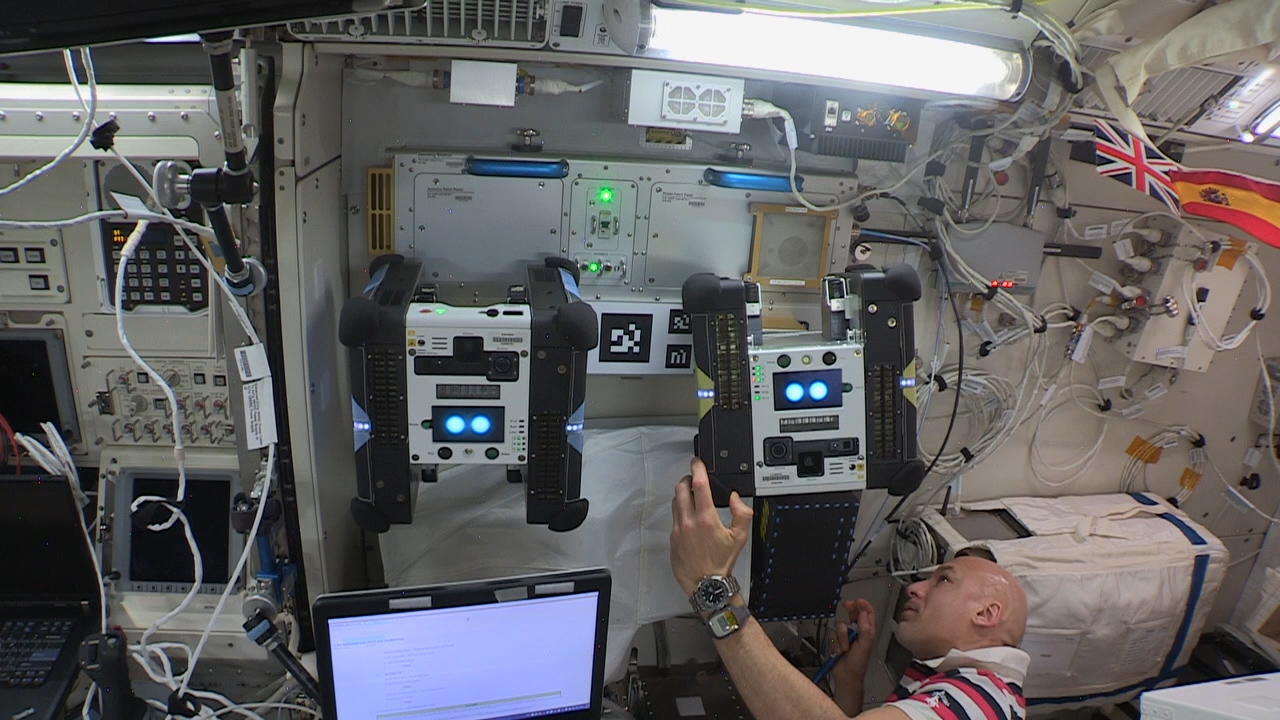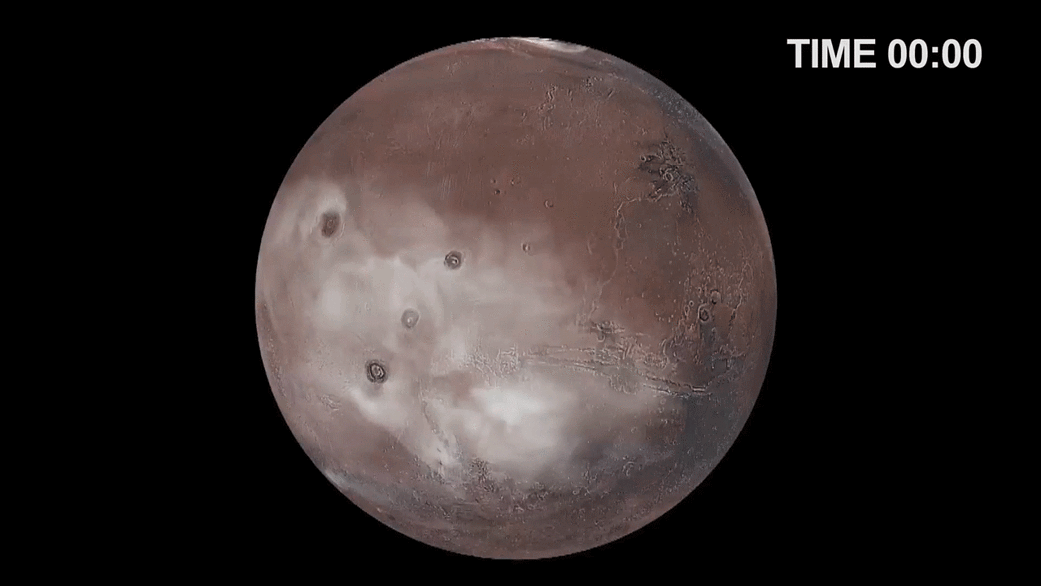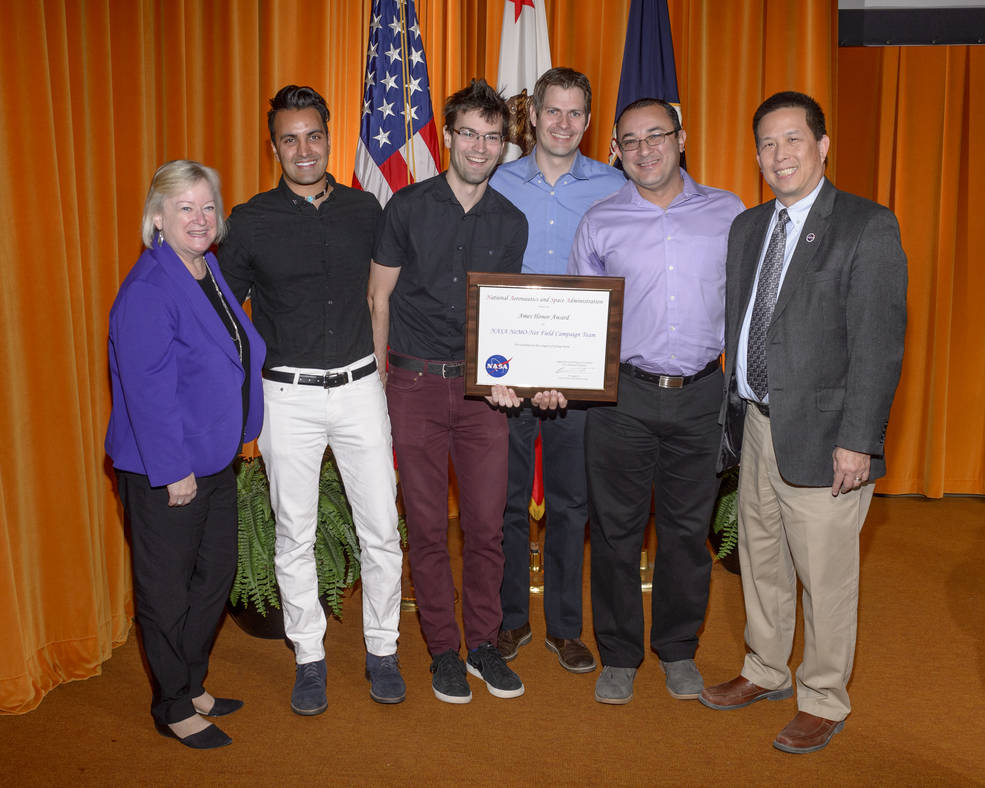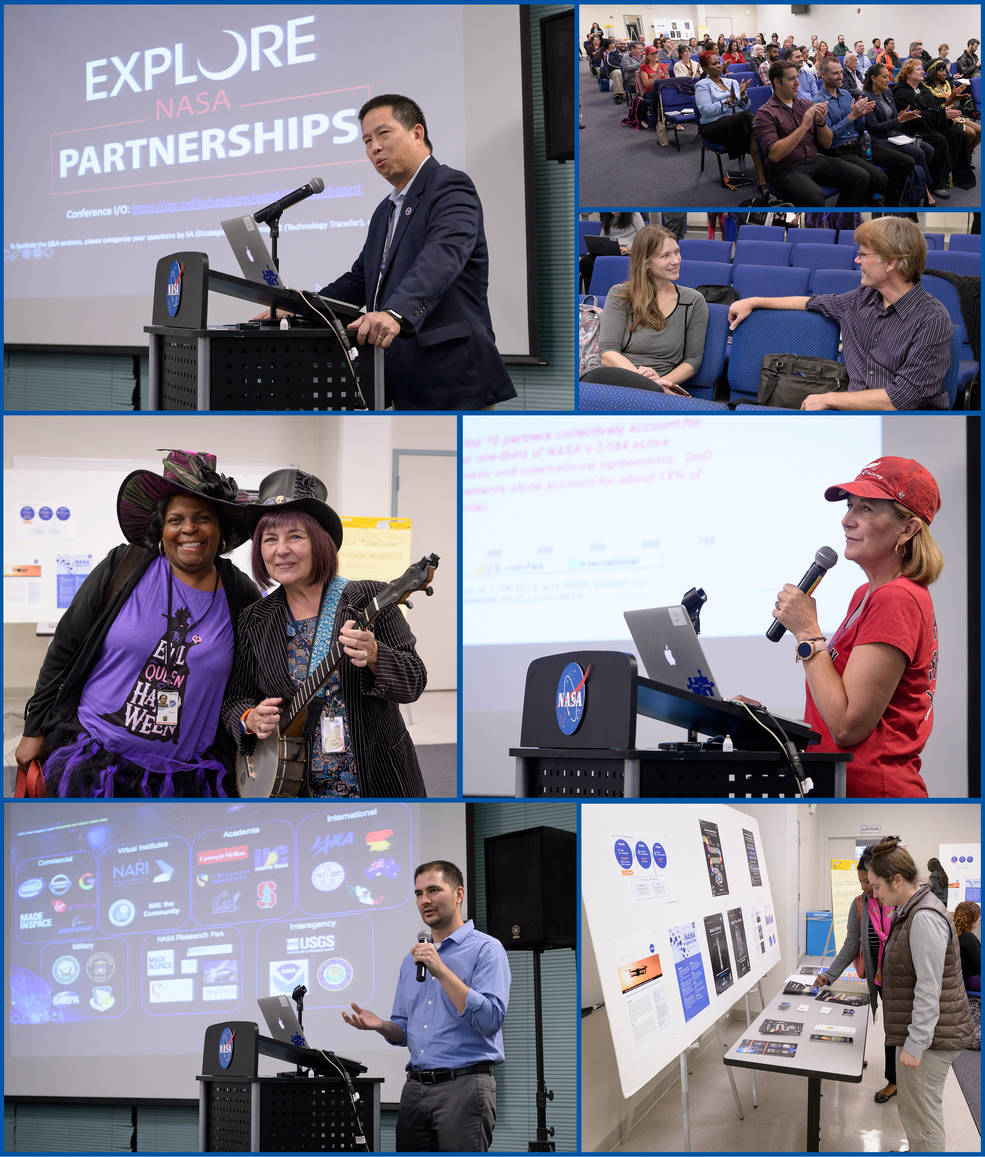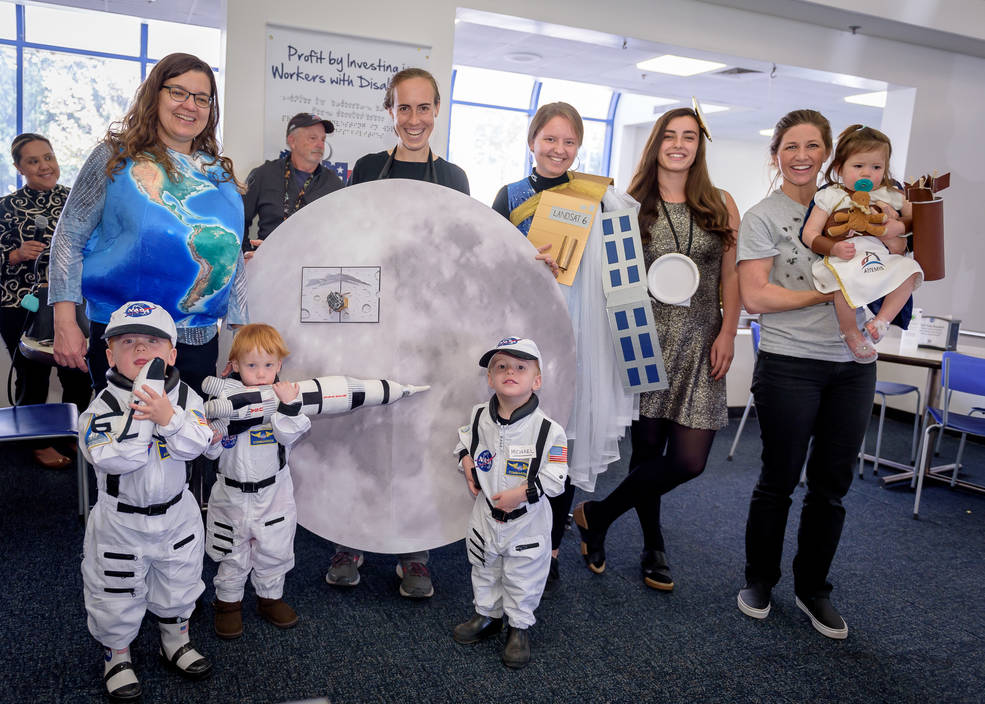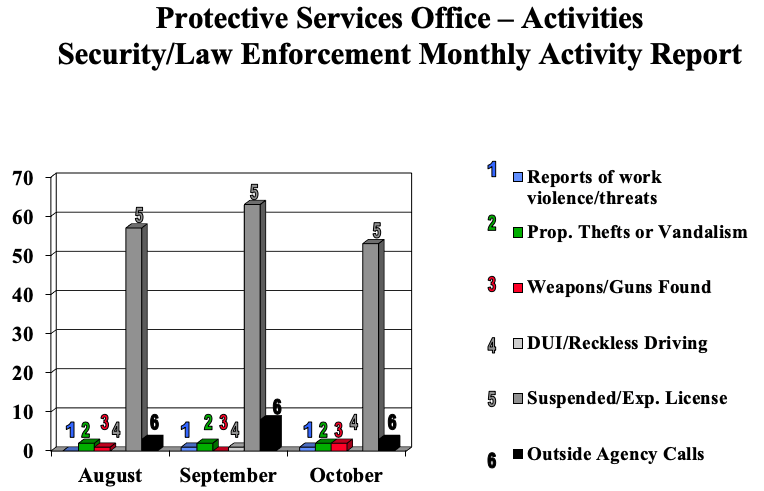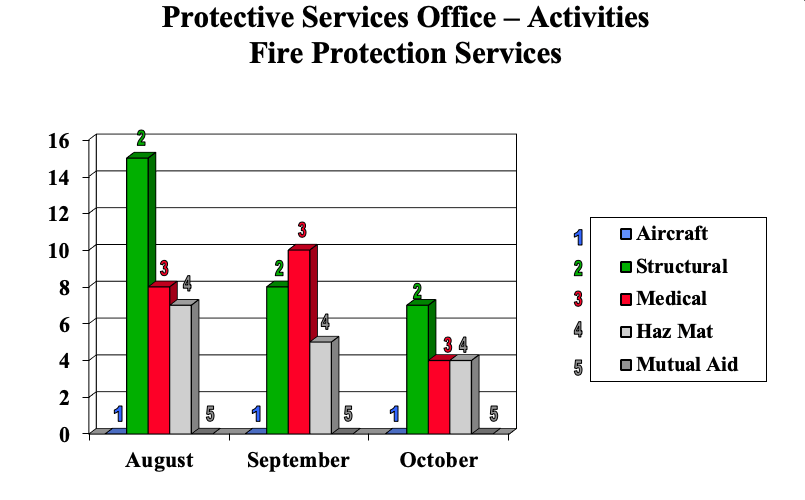November 2019 issue of Ames' newsletter, the Astrogram
Pence Calls on NASA in Silicon Valley to Write the Next Chapter for America in Space
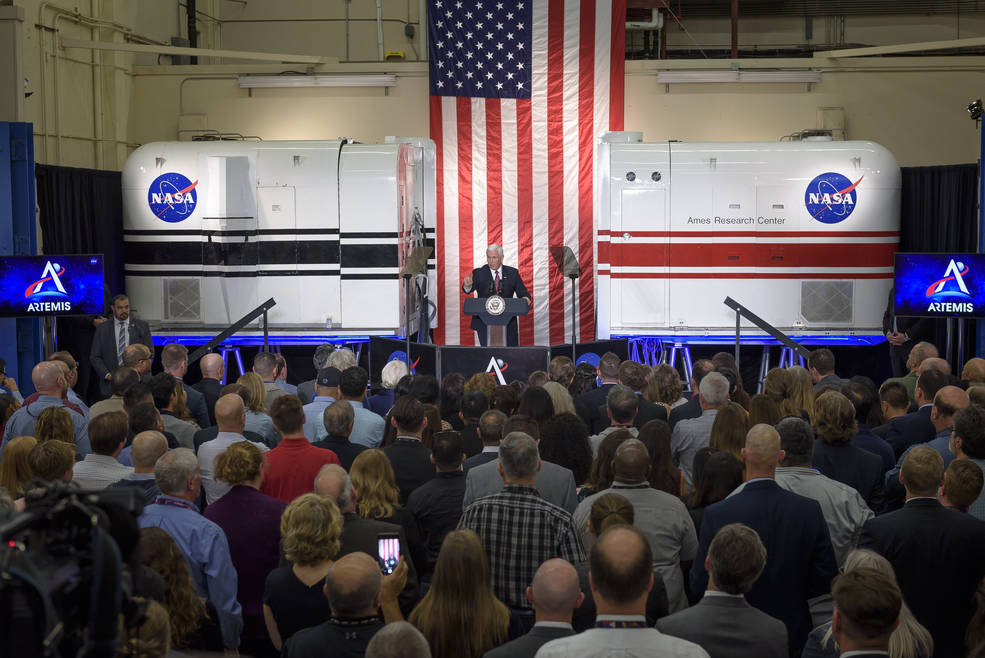
by Abigail Tabor
A rich history, 21st-century expertise and the technological leadership of a one-of-a-kind region stood front and center during Vice President Mike Pence’s visit to NASA’s Ames Research Center in California’s Silicon Valley on Nov. 14, 2019.
Touring with NASA Administrator Jim Bridenstine, the vice president commended Ames’ innovators and visionaries for their role in building Silicon Valley into a technological powerhouse and in bringing expert knowledge and dedication to the center’s endeavors today. Pence learned about some of these during his time at Ames, with visits to facilities and projects critical for the Artemis program.
For full story, see: PenceVisitsAmes
Black Hole or Newborn Stars? SOFIA Finds Galactic Puzzle
by Kassandra Bell
Even celestial objects can seem like they’re playing tricks. In a new study, scientists are puzzled by a black hole that seems to be changing its galactic surroundings in a way that is usually associated with newborn stars.
Black holes are inherently strange, with gravitational forces so strong that nothing, not even light, can escape. As active black holes consume gas and dust, some of that material is instead launched outward as jets of high-energy particles and radiation. Usually these jets are perpendicular to the host galaxy, but NASA’s Stratospheric Observatory for Infrared Astronomy, or SOFIA, found one that is shooting directly into its galaxy.
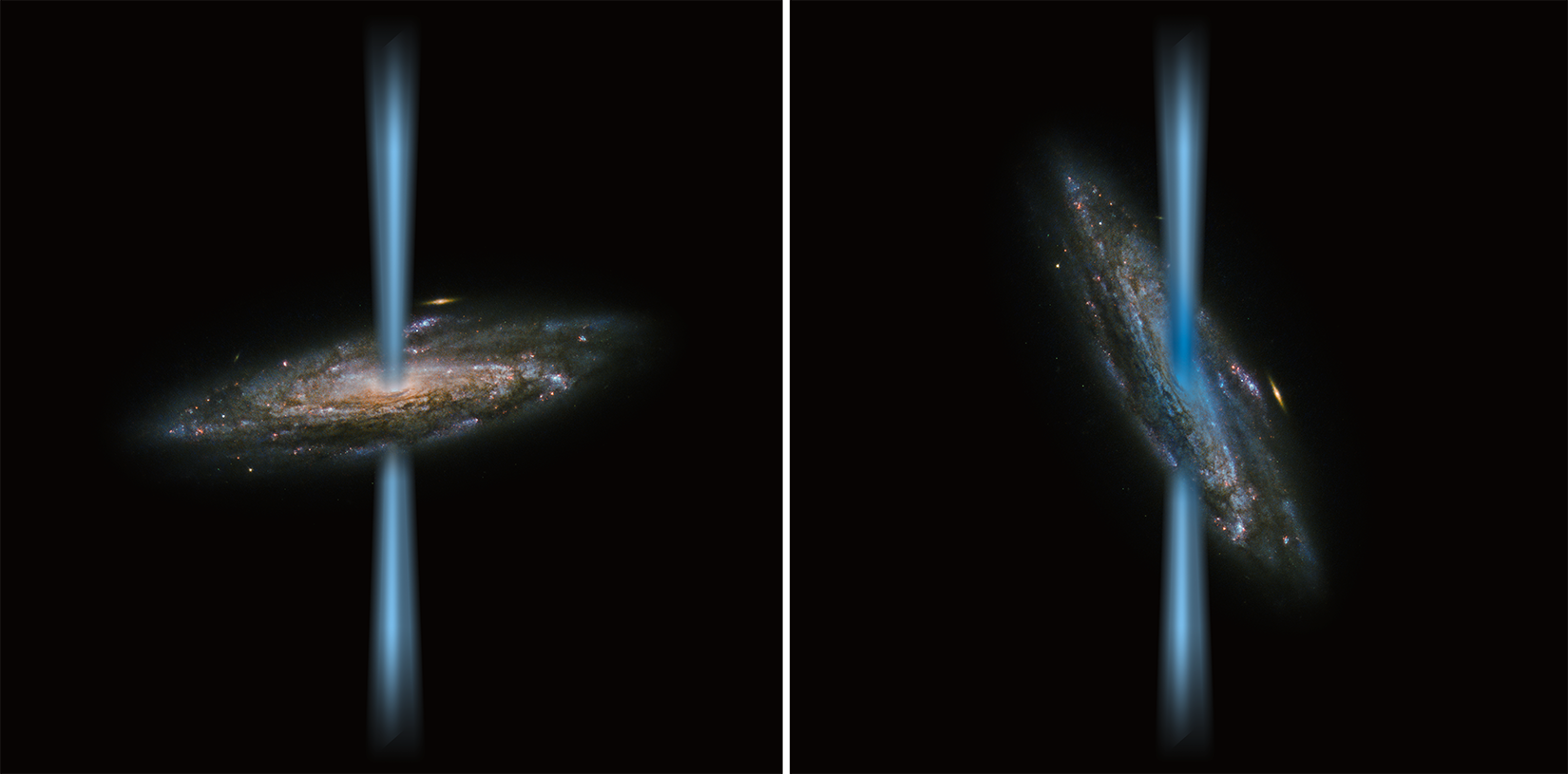
For full story, see: SOFIAGalacticPuzzle
What is NASA’s Aerobiology Lab?
The Answers to Life Are up in the Air
by Abigail Tabor
It’s easy to think of our atmosphere as just an empty space above the ground, but it’s home to a wide diversity of microorganisms, including bacteria, viruses and fungi. These tiny life forms may hold clues to big questions, such as where and how life evolved and if it exists elsewhere in the universe. Scientists in the Aerobiology Lab at NASA’s Ames Research Center, in California’s Silicon Valley, are working to develop methods to test how and how well different types of microbes survive in the extreme conditions of the atmosphere.
What is Aerobiology?
Aerobiologists study the organisms and particles of biological origin – known together as bioaerosols – that float around in our planet’s atmosphere. Some try to understand how bioaerosols get into the atmosphere in the first place – for instance, by thunderstorms, volcanic activity, fire or dust storms – as well as how bioaerosols are lofted by prevailing wind currents. Others study the impacts bioaerosols can have, like influencing air and cloud chemistry. More questions surround how long they can stay afloat in the atmosphere and how long and in what conditions airborne microbes can survive. In recent years, aerobiology researchers have also begun to explore whether our atmosphere might hold entire ecosystems of airborne microbes and whether interactions between species in the atmosphere can allow microbes to evolve while in the air.
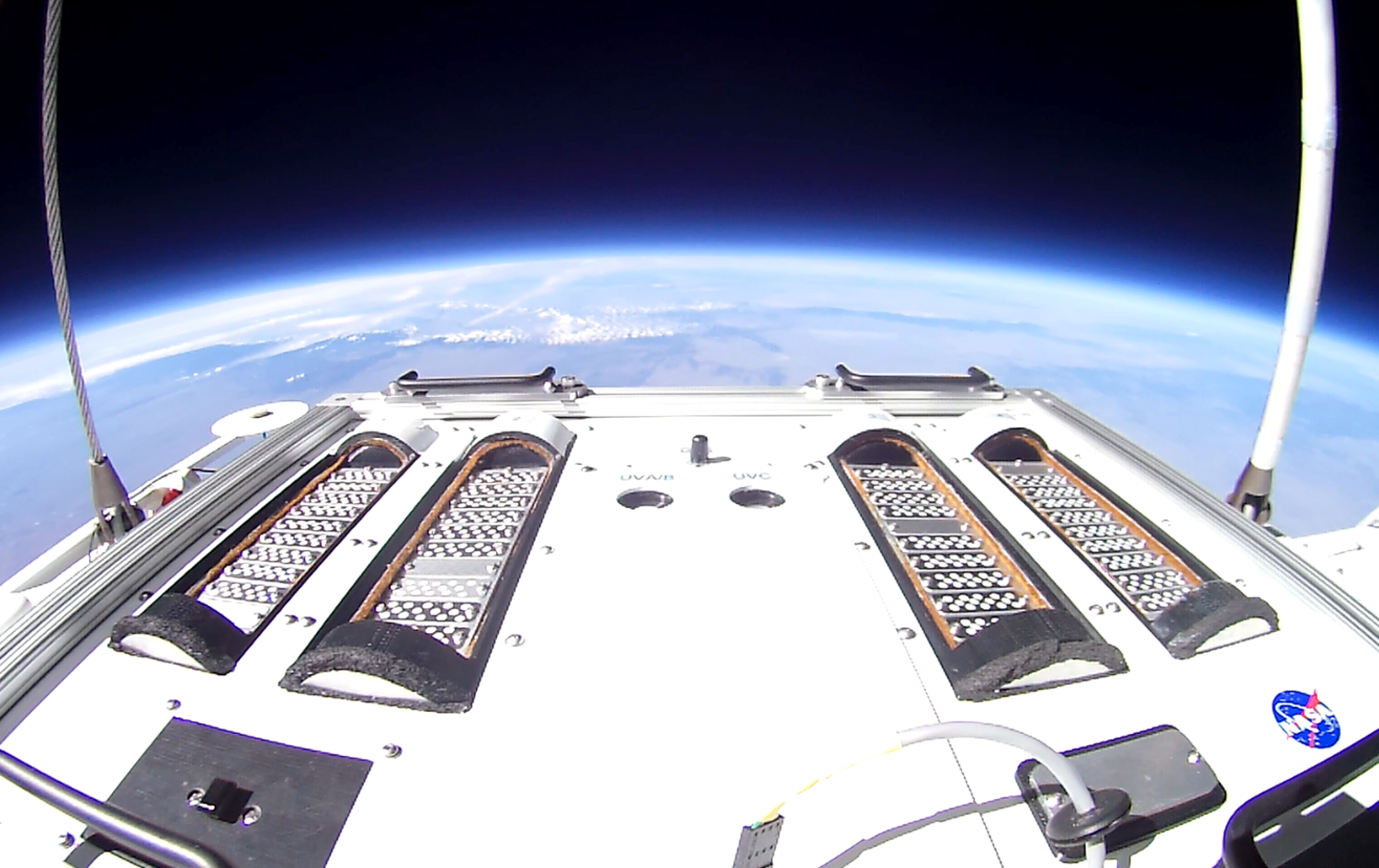
For full story, see: AerobiologyLab
NASA’s Second Astrobee Wakes Up in Space
by Gianine Figliozzi
European Space Agency astronaut Luca Parmitano performed initial tests of the second Astrobee robot, named Honey, aboard the International Space Station. Astrobee is a free-flying robot system that includes three robots and a docking station for recharging, and will be used to test how robots can assist crew and perform caretaking duties on spacecraft.
After Parmitano unpacked and inspected Honey, he placed the robot on Astrobee’s docking station and Honey woke up on the dock, for the first time in space, next to its robotic teammate Bumble. Honey and Bumble are identical, except for their colors. Bumble is dressed in blue and Honey, appropriately, wears yellow.
For full story, see: SecondAstrobee
Predicting Extreme Acoustic Vibrations to Keep Astronauts Safe During Launch
by Gianine Figliozzi
During NASA’s Artemis missions, the Orion spacecraft will sit atop the most powerful rocket in the world to launch humans to deep space. Orion will carry the first woman and next man to the Moon by 2024 and return them safely back to Earth. An integral part of ensuring astronaut safety on these, and other human missions, is a launch abort system that can propel the crew module away from the rocket in a split-second, if a life-threatening event arises during launch.
The maneuver of such a system resembles the action of an “eject button” for a crew capsule, involving rapid acceleration and intense pressure waves. The waves emanate from the abort motor’s hot turbulent exhaust plumes, impinge on the crew capsule and can cause vibrations. Such vibrations need to be analyzed to ensure the system doesn’t shake itself apart. Direct measurements from flight tests — using sensors attached to the surface of vehicle — is the current gold standard. But the number of flight tests is limited by cost and safety considerations.
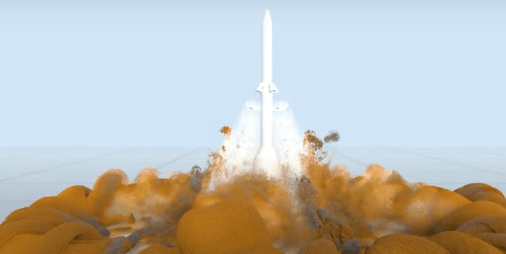
Illuminating the Gas Between Galaxies with Supercomputing
by Frank Tavares
Galaxies contain millions of stars, and they grow by pulling in gas to make even more. How gases ebb and flow between galaxies and their surroundings is an essential question that NASA’s supercomputers are helping to answer.
Galaxies are constantly pulling in new gas that forms new generations of stars. As these stars evolve and eventually die, they often explode as supernovae – ejecting gas filled with new chemical elements back into intergalactic space. In this way, the gases between galaxies serve as a reservoir of recycled material that’s available to create new stars.
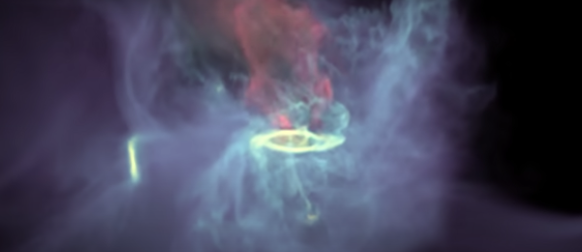
For full story, see: IlluminatingGas
NASA’s All-Electric X-57 X-Plane: A Cleaner Way to Fly
by Abigail Tabor
Just as electric cars are becoming more and more commonplace on our roads each day, aerospace engineers are seeking to make electric air transportation a reality. In pursuit of that goal, NASA is developing its first crewed X-plane in more than 20 years, the X-57 “Maxwell” electric experimental aircraft. Compared with conventional aircraft, the X-57 team has set a goal of using five times less energy and – if powered by electricity generated from renewable sources – producing zero inflight carbon emissions.
The X-57’s unique propulsion system, in its final configuration, features 14 battery-powered electric motors and propellers: 12 to provide lift during takeoff and landing, and one at the tip of each wing to provide forward thrust during flight. In order to understand the aerodynamic effects of this design, a team of engineers from three NASA centers – Ames Research Center in California’s Silicon Valley, Langley Research Center in Hampton, Virginia, and Armstrong Flight Research Center in Edwards, California – is using supercomputers to simulate flight conditions for the X-57
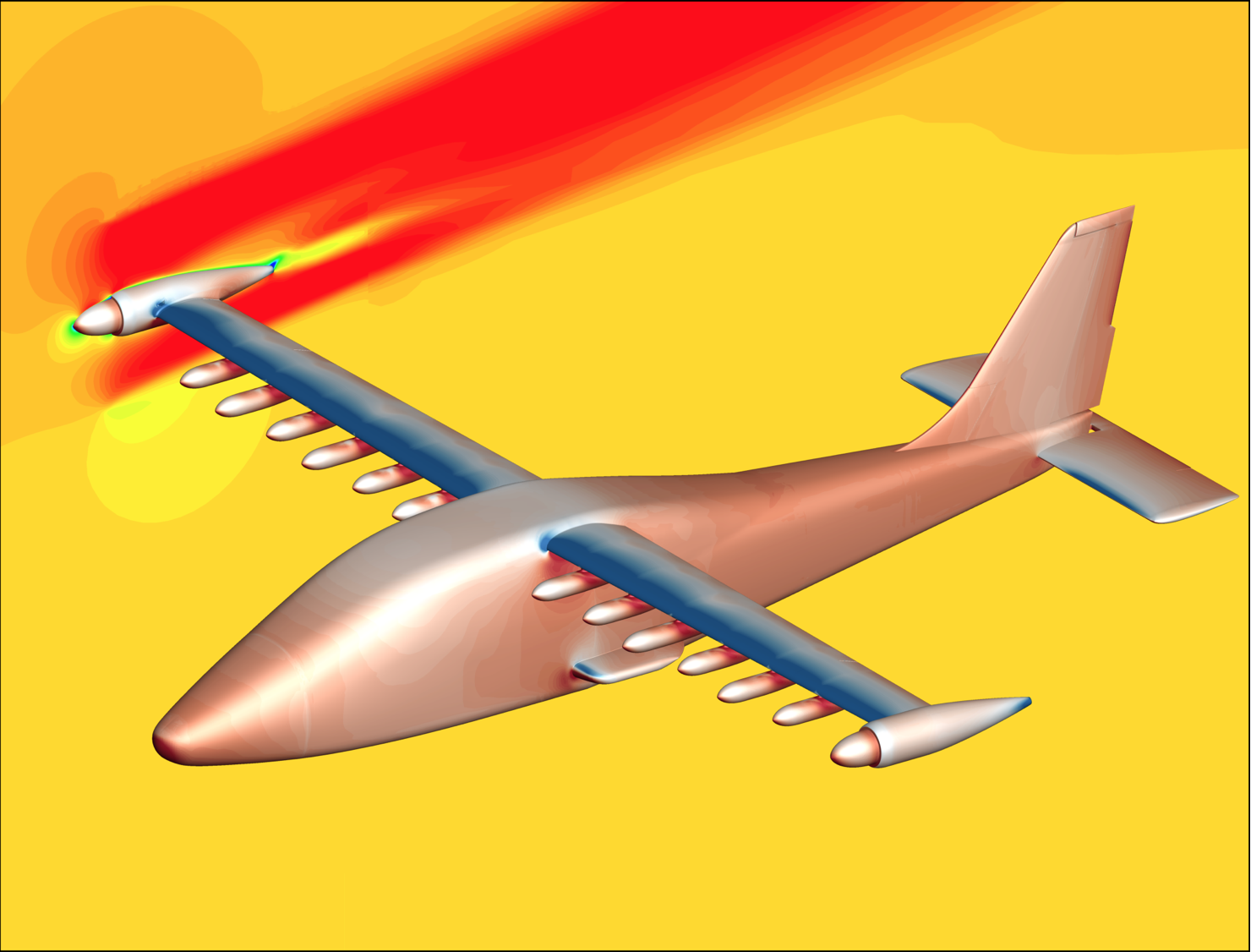
For full story, see: X57XPlane
A Cloudy Martian Night, Through the Eyes of a Supercomputer
by Abigail Tabor
As NASA’s Curiosity rover makes its way over the surface of Mars, it’s sometimes accompanied by clouds drifting by in the sky above. Like Earth, the Red Planet has a water cycle, with water molecules moving between the surface and the air, traveling through the atmosphere and coming together to form clouds. The behavior of water-ice clouds on Mars plays a big role in its climate, and this computer simulation shows them forming and dispersing over the course of a Martian day.
At the time of year shown here – summer in Mars’ northern hemisphere – clouds form slowly overnight near the equator and are at their thickest just before the sun rises. They disperse quickly as the day warms up and begin to reform around dusk. Several peaks of Tharsis Montes, a chain of volcanoes, can be seen jutting through the clouds.
For full story, see: MartianNight
From Wind to Data, in No Time Flat: Accelerating Spacecraft and Aircraft Design
by Abigail Tabor
NASA is preparing to send astronauts to explore the Moon’s south pole within the next five years as part of the Artemis program. Knowing that time is of the essence, NASA aerospace engineer Nettie Roozeboom thought of an idea that could speed up significantly the design of rockets, lunar landers and other spacecraft to support lunar exploration. By linking in real time two NASA facilities – one for advanced aeronautics testing, the other for powerful analysis of the results – her method could define a new way of doing business in the world of spacecraft and aircraft design. Last month, she showed how it could work during the latest tests of NASA’s new rocket, the Space Launch System, or SLS.
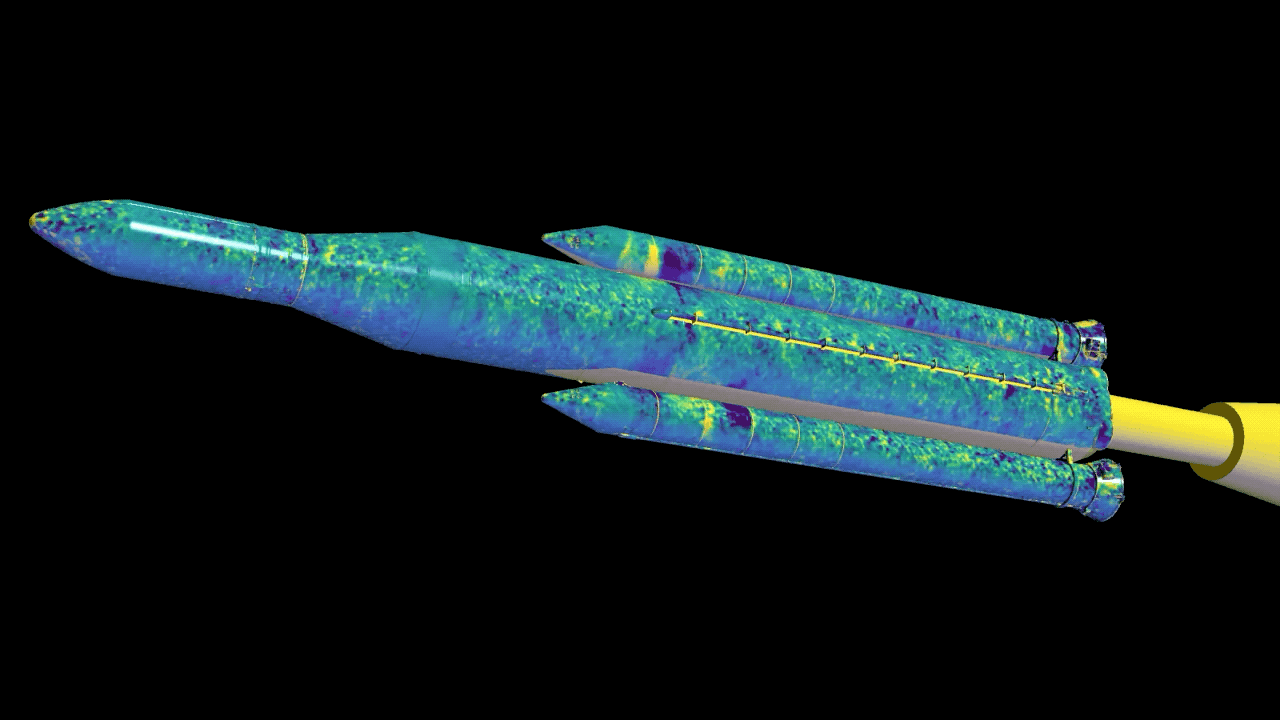
For full story, see: WindtoData
Ames Employees Recognized at 2019 Ames Honor Awards Ceremony
This year’s Ames honorees received their awards at a ceremony on Nov. 7, 2019, in the Syvertson (Main) Auditorium. Thanks to every employee who submitted a nomination this year, and congratulations to these deserving employees. A list of those honored follows:
2019 AMES HONOR AWARDS
Administrative Assistant Support/Secretary
Norma J. Caldwell
Administrative Professional
Lyda Little
Gabriel Lozano
Best First Paper
William J. Coupe
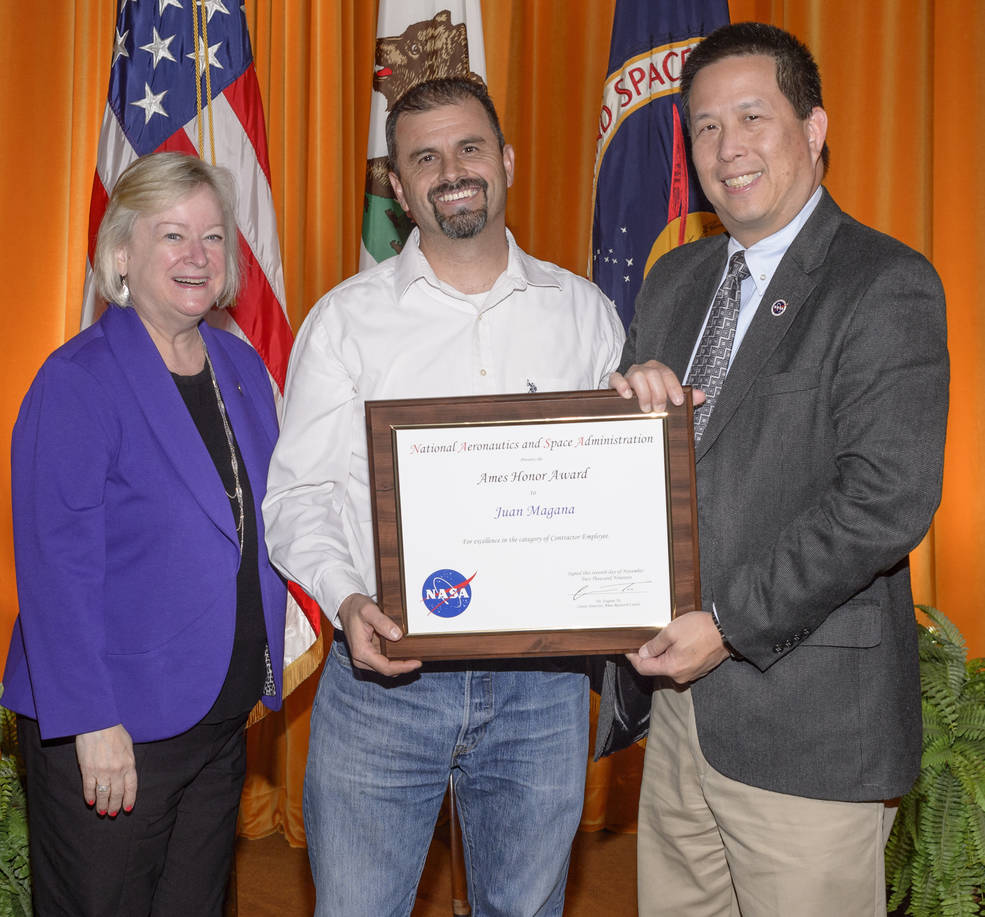
Contractor Employee
Manka Ahluwalia, WYLE Labs
Geoffrey A. Ament, Science and Technology Corporation
Pamela A. Beato-Day, MIRACORP Inc.
Javier Contreras, MIRACORP, Inc.
Carla D. Ingram, SimLabs III Contract Management & Technical Services
Kenji H. Kato, ASRC Research & Technology Solutions
David R. Keil, JACOBS
Melissa Kirven-Brooks, WYLE Labs
Juan Magaña, Ames Exchange
Jimmy Nguyen, Universities Space Research Assn.
Nathaniel T. Smith, JACOBS
Priya Venkatesan, SGT Inc.
Bill Wohler, WYLE Labs
Diversity and Equal Opportunity
Carolina Rudisel
Education and Outreach
Jonas G. Dino
Engineer
James T. Heineck
Group/Team
Ames Federal Employees Union
BioNutrients-1 Team
Cross Program Launch Commit Criteria Management System (CP-LMS)
EuCROPIS PowerCell Team Helium Hydride Public Affairs Team
NASA Ames UAS-NAS ACAS Xu Team
NASA Aviation Safety Reporting System (ASRS) and Confidential Close Call Reporting System (C₃RS)
NASA NeMO-Net Field Campaign Team
Scientific and Technical Information (STI) Team
SimLabs Lunar Lander Demo Team
TechEdSat Team
Mentor
Nettie H. Roozeboom
Jay Shively
Gloria K. Yamauchi
Partnerships
Michael C. O’Neil
Project Management
Matthew D’Ortenzio
Scientist or Researcher
Erin E. Flynn-Evans
Special Appreciation
Donna L. Dempsey, Johnson Space Center
John A. Saltzman, Armstrong Flight Research Center
Student
Jennifer Chang
Benjamin W. Margolis
Supervisor/Manager
Latasha L. Ferguson
Albert C. Maese
Sharon E. Mckee
Brandon P. Ward
Technician
Kent A. Stednitz
Avi Barliya Discusses the Technical Challenges and Benefits of Serverless Computing
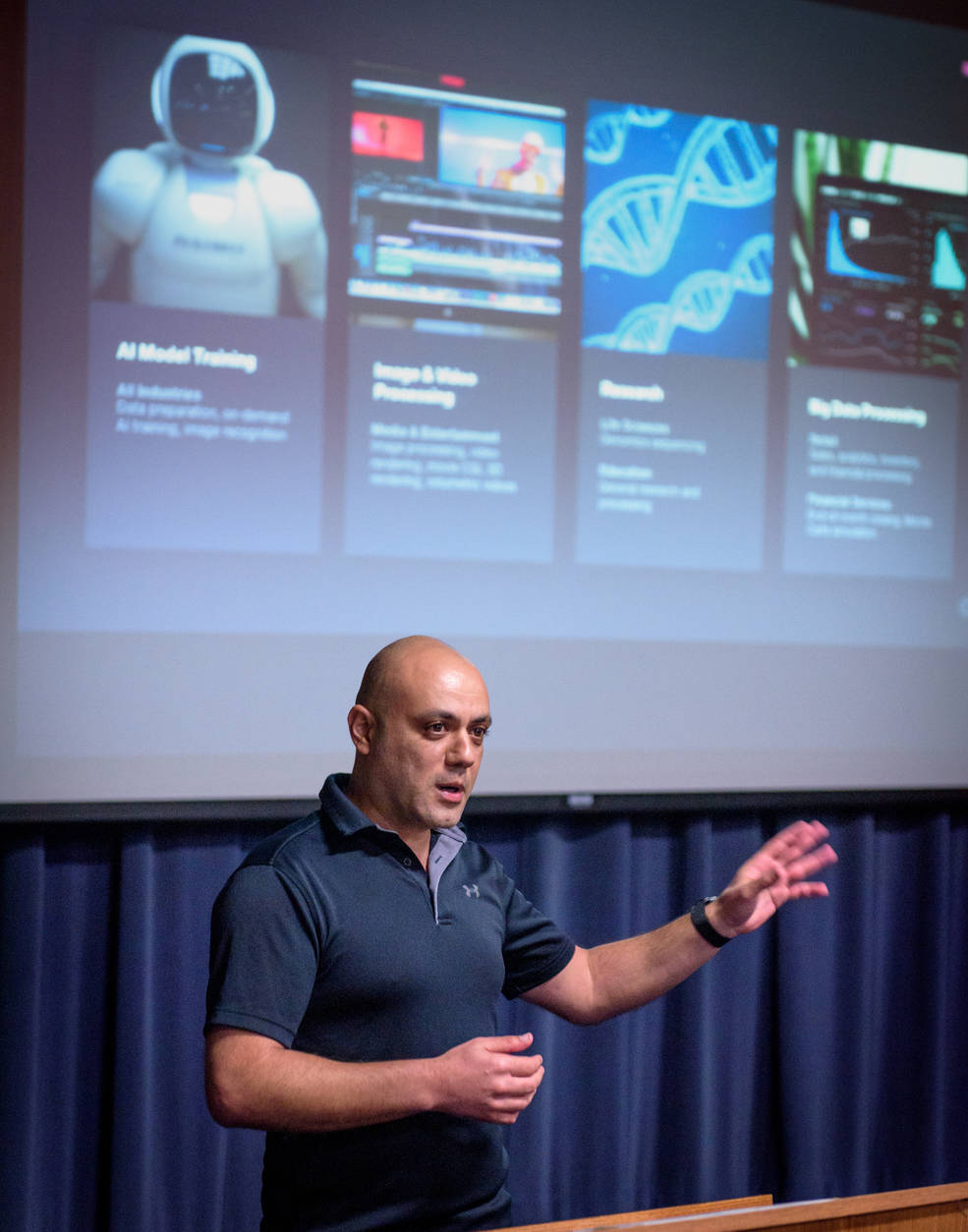
Ames Technology Showcase Highlights Cutting-Edge Research
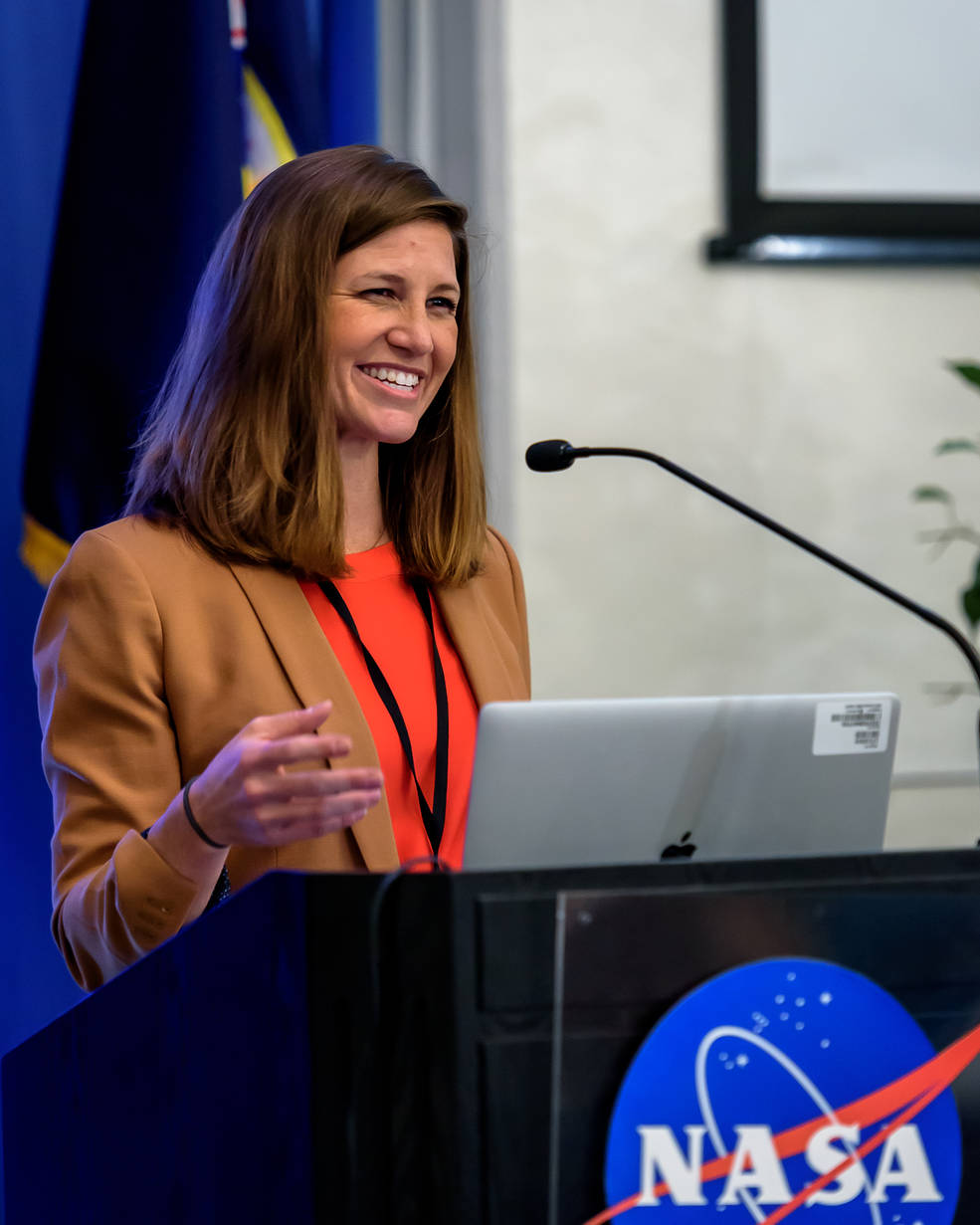
In Memoriam
Walter Vicenti, Revered Pioneer in Supersonic Wind Tunnel Research, Passes Away
Walter Vincenti, as a young engineer in the Ames wind tunnels from 1940 to 1957, helped lay the mathematical foundation for supersonic flight and generated test data enabling swept wings on jet aircraft. Over his long career, he accomplished so much more. The AIAA awarded Vincenti its 2016 Guggenheim Medal for a lifetime of achievement in aerospace, citing his: “seminal pioneering supersonic wind tunnel research, education in high temperature gas dynamics, and exceptional contributions to the history of engineering technology.” Vincenti died on Oct. 11, 2019 in Palo Alto. He was 102. Walter Guido Vincenti was born on April 20, 1917, to Italian immigrants. He grew up in Pasadena, nearby Caltech, though he followed his brothers to Stanford University. He studied under the great William Durand and graduated with an engineer’s degree in mechanical engineering in 1940.
Two weeks before graduation, Vincenti joined the new NACA Ames Aeronautical Laboratory as its fifth engineer. During the war years, he focused on building wind tunnels and solving problems discovered as American fighter aircraft pushed their limits. After the war, Vincenti led the new 1-foot-by-3-foot supersonic wind tunnel at Ames that generated data fundamental to theories of efficient high-speed flight. Vincenti’s branch at Ames gave aircraft companies knowledge useful to design and build swept-wing aircraft that routinely broke the sound barrier. “That sort of fundamental engineering — solid data and elegant mathematics in advance of industrial need — was what made the NACA such an exemplary federal agency,” notes former Ames historian Glenn Bugos. “Walter had a profound and enduring impact on the research culture of Ames, as he would later at Stanford and as a historian of technology.”
In 1957, Stanford University offered Vincenti a full professorship and tasked him with re-invigorating their department of aeronautics and astronautics. Vincenti’s teaching, research and writing while at Stanford focused on physical gas dynamics, the theory of air flow around reentry vehicles. Vincenti built a hypersonic wind tunnel at Stanford and in 1965 co-authored the textbook “Introduction to Physical Gas Dynamics,” which remains a foundational book in the field.
Vincenti then embarked on a third career. While at the NACA, he earned a reputation for writing beautifully. He matched his writing skills with a concern, born in the tumult of the 1960s, about the societal impacts of accelerating technology. In 1971, he founded the Stanford Program in Values, Technology and Society, the second such interdisciplinary program in America. He started writing history, and in 1990 published the award-winning “What Engineers Know and How They Know It.” In a series of engineering case studies, some harking back to his days with the NACA, Vincenti illuminated the processes of engineering epistemology — how engineers overlay data, theory, and rules-of-thumb well enough that they feel certain enough to commit to a specific design.
Vincenti earned many honors, notably in both engineering and the humanities. His honors include the 1948 Pi Tau Sigma Gold Medal and a 1956 Rockefeller Public Service Award for advanced study at Cambridge University. He was a member of the National Academy of Engineering, and a corresponding member of the International Academy of Astronautics. For his devotion to students, many of whom later worked at NASA Ames, in 1983 Stanford awarded him the Lloyd W. Dinkelspiel Award for outstanding service to undergraduate education. In 1998, Vincenti was honored for his contributions to the history of technology with the Leonardo da Vinci Medal, the lifetime achievement award of the Society for the History of Technology.
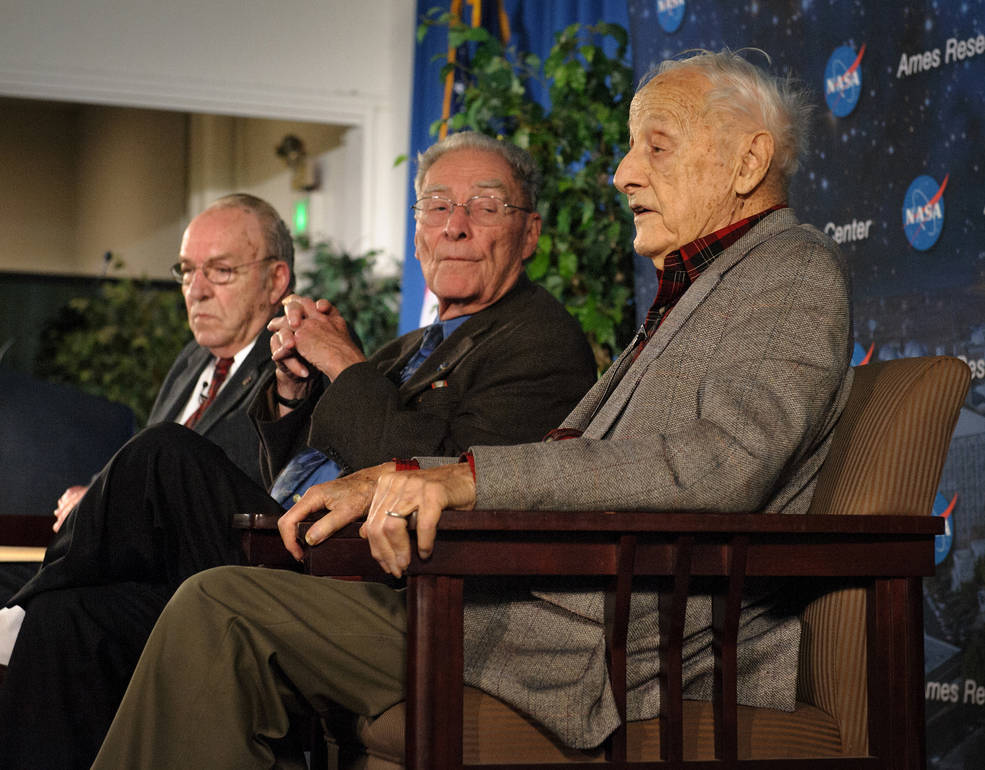
“Walter was a great human being,” remembers Jack Boyd, senior advisor to the Ames center director. Vincenti was Jack’s first boss when he arrived at Ames to work in the 1-foot-by-3-foot wind tunnel. “Walter was a superb engineer, very kind, of great integrity and always supported younger scholars. He was a great friend and mentor to many.”
In 1947, while returning from an NACA conference on a westbound train and stalled by a flood in Iowa, he met his future wife, Joyce, herself returning to California from a teaching stint in Cuba. Joyce died in 2013. Walter is survived by his daughter, Margi Vincenti-Brown, and son, Marc Vincenti; his granddaughters, Gena Thueux and Juliette Harris; and his great-grandchildren, Gwendoline and Max Thueux, and Michaela and William Harris. A memorial service is being planned for Jan. 17, 2019, at Stanford University.
Roy Hampton, Ames Engineer and Internationally Recognized Fracture Mechanics Expert, Dies
Roy W. Hampton, a longtime mechanical engineer in the Systems Engineering Division, passed away Nov. 19, 2019. He worked for more than 37 years at NASA Ames on most of the critical experimental facilities at the Center.
Born in Atlanta, Georgia, Roy traveled with his parents, Mary Iva and Wayne R. Hampton, and his sister Donna Jean to Turlock, California, in 1952. There, Roy attended grade school and high school, where he graduated with honors. He then attended San Jose State University, where he graduated with a bachelor of science in mechanical engineering. He came to NASA Ames in 1968 to work in the Mechanical Facilities and Equipment Branch. He went on to attain a master’s degree from Stanford University.
Roy’s passion for space exploration and engineering excellence made a tremendous impact on flight safety for many programs. Over his career, he made critical contributions to many projects both at Ames Research Center and for the entire space agency. These included design and evaluation of many complex mechanisms in the Ames wind tunnel test facilities, structural safety analysis of many NASA aircraft platforms as well as critical work for the centrifuge rotor project for the International Space Station. His aim was always to ensure human safety and mission success above all.
He was an internationally recognized expert in the science and application of fracture mechanics, developing and implementing many of the fracture control methods and standards used by NASA today. He was awarded the Silver Snoopy for astronaut safety, an award that is given directly by NASA astronauts to individuals who have performed outstanding work in support of human spaceflight. Even after retirement, he was dedicated to contributing to his field, continuing to lend his expertise as a fracture mechanics expert to the NASA Engineering and Safety Center, helping his colleagues and working as an independent contractor up until his death.
Roy met his wife, Yvonne F. Lopez, on a Sierra Club backpacking trip in Klamath, California in 1971. He was immediately impressed with her beauty and resilience, and she loved him for his kindness and sense of fun. They married in August of 1973. Together they made a home in Cupertino, where they raised their three children, Summer, Sierra and Bryce. Throughout their loving marriage of more than 46 years, they fell in love over and over again.
Roy was the heart of his family. The family trips he carefully planned were a highlight for his wife and children. A lover of nature, music, art and fine detail, he was always happy to explore a trail, a zoo, or a museum collection, especially in company of friends and family. Everything he knew or learned he humbly shared. He delighted in discussing a project’s intricacies, from his handiwork at home to his professional career. A kind and empathetic soul he treated all with attentive dignity. His wisdom, generosity and prescience guided everyone. We all will forever miss his sage and thoughtful advice and his engaging humor and happy dimpled smile.
Roy is survived by his wife, Yvonne Hampton, their three children, and six grandchildren, as well as by his sister and her husband, Donna and Mike Wagner and by extended family through his children’s marriages. Roy’s family and friends are celebrating his life privately.
Ames Strategic Partnerships Office Holds “Explore Partnerships!” Workshop for Employees
On Oct. 31, 2019, the Ames Strategic Partnerships Office celebrated Halloween by holding a workshop for NASA Civil Servants and Contractors to learn about working with the Ames Strategic Partnerships Office. Special guests included the Ames Center Director Eugene Tu and the Deputy Director of the HQ Partnerships Office Diane Frazier. The workshop covered topics from the Strategic Agreements at Ames Office, Technology Transfer Program and SBIR/STTR Program, in hopes to spark interest for potential partnerships that will take us to the moon and beyond!
If this piques your interest, you can view the presentation slides and the answers to questions asked throughout the workshop. We encourage you to contact the Ames Strategic Partnerships Office to answer any additional questions or for more information.
Additional Resources:
- PowerPoint Slides from Ames Strategic Partnerships Workshop 2019
- FAQ’s from Ames Strategic Partnerships Workshop 2019
- Workshop Questionnaire
- Ames Strategic Partnerships Website (General)
- Strategic Agreements Website
- ARC Technology Transfer Website
- SBIR/STTR Website
- Partnerships Community of Practice

